ACROSS EUROPE ALONG THE INLAND WATERWAYS
FROM THE NORTH SEA TO THE MEDITERRANEAN
Ecland logbook 2019-2020
STEP ONE: 2019
We sailed out of the Mediterranean with Ecland in August 1992. After several years of cruising along the European and American sides of the Atlantic, we sailed back to Europe in 2011, along the Norwegian coast, up to the Svalbard islands, in the Baltic Sea, and at the end of August 2018 we came to Amsterdam, with in our minds the idea that after some 60.000 miles the time was arrived to go back to the Mediterranean.
The Atlantic coasts of Europe from the Channel to Gibraltar, after years of cruising, were not supposed to keep many surprises, so I began considering the inland waterways to sail back to the Mediterranean.
My first idea was to cross Europe from west to east during two seasons, along the waterways of Holland, Belgium, Germany (the Rhine and the Main), and then entering the Danube as far as its mouth in the Black Sea, returning into the Mediterranean through its backdoor of the Bosforus, so I began studying the feasibility of this plan. Thanks to the invaluable documentation given by Tom Sommers on his website www.eurocanals.com, to the wonderful digital charts by the Dutch Stentec, and to a few chats with others who already made the passage, I finally came to the conclusion that this was not the most appropriate options for us: the length of the journey, the bureaucratic problems, the difficulty in finding a safe spot at mid-way to leave the vessel wintering, and the uncertain variability of depths in the Danube river, all this convinced me to look for another option, that allowed me to cross Europe along the inland waterways during two seasons of one month each, but at the same time gave me some more certainty in maintaining the plans, in a geographical area with more chances to find a safe place for Ecland between the first and the second year.
There was only one solution: crossing from north to south, along the waterways of Holland, Belgium, and France, getting out into the Mediterranean at the mouth of the Rhone, not far from Marseille. So I plunged back into charts and documents, and after having checked the feasibility from a dimentional point of view (draught and width), I decided to pursue this second option.
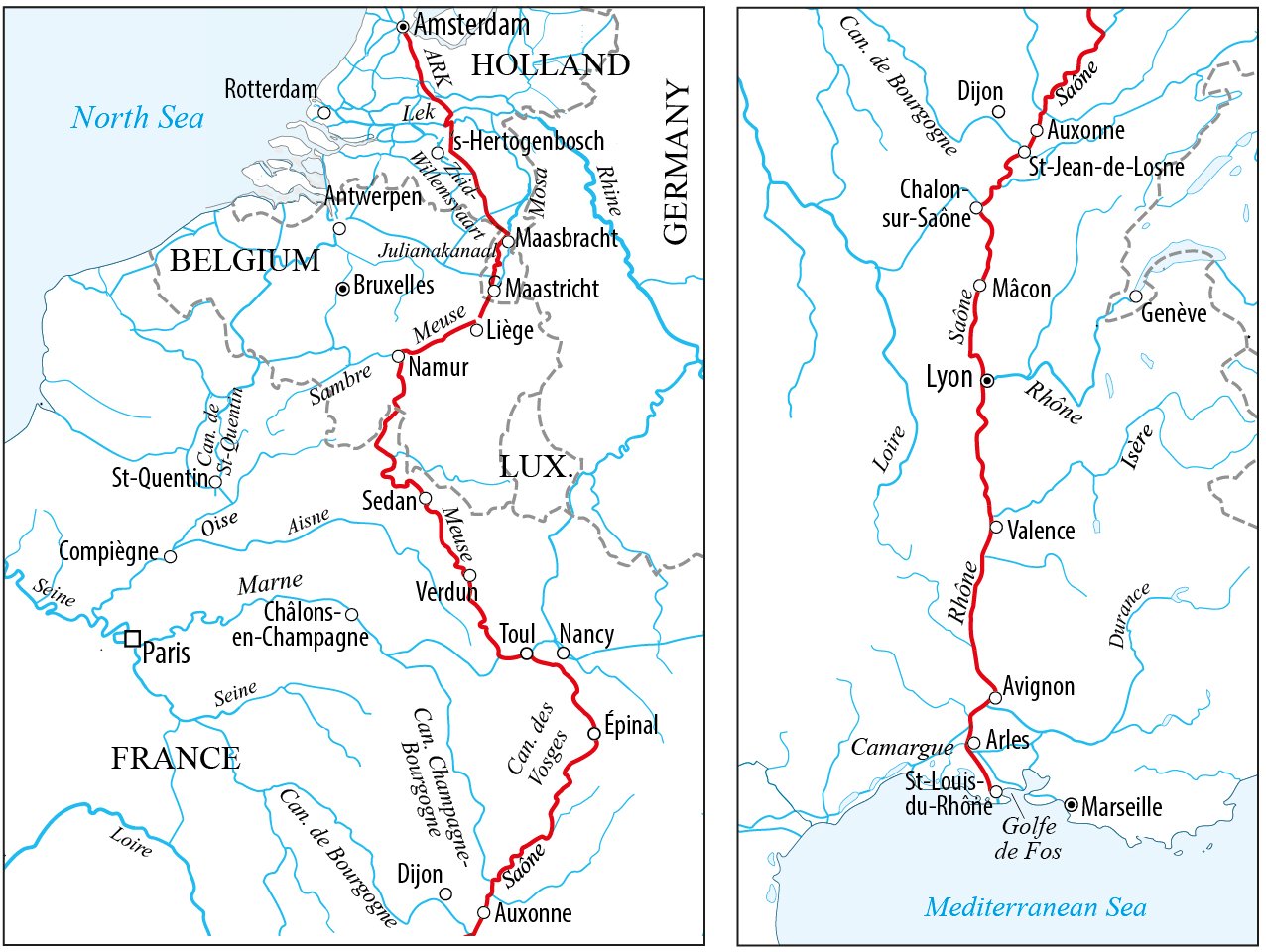
The expected routes for 2019 and 2020.
The planned route was the following: in the first year, the Amsterdam-Rijn Kanal, some zigzag in minor canals down to the area of ‘s-Hertogenbosch, the Zuid-Willemsvaart down to Maasbracht, the Julianakanaal down to Maastricht, and then the river Meuse across Belgium and northern France; from here, the Meuse channel down to Toul, the canal of the Vosges until its intersection with the river Saône, stopping for the winter in the area of Saint-Jean-de-Losne (not far from Dijon for logistic reasons), which is considered the most important crossroad in Burgundy. In the second year, the river Saône from Dijon to Lyon, and then the river Rhone down to the sea.
With some e-mail exchanges, I reach an agreement with Vassili Zadora of H2O in Saint-Jean-de-Losne, booking a mooring in Port Royal in Auxonne, some 20 kilometres upstream but handled by the same company, from the end of August 2019 to July 2020, and another agreement with the staff of Port Napoléon, in the gulf of Fos next to the mouth of the Rhone, for a mooring from end of August 2020 and for stocking my mast for one year starting from the beginning of the first season.
I have indeed decided not to carry my mast on deck: it would stand in our way for the whole cruise, and would also be an obstacle to a safe navigation, as my mast is 3 meters longer than the hull; this passage should be a cruise rather than a transfer. I found out and got in touch with Rainer Petras of Fastmast, a German guy whose profession is transferring masts everywhere in Europe, who will pick up my mast and my boom in Amsterdam and drop them down at Port Napoléon, using a funny van with a long trailer behind.
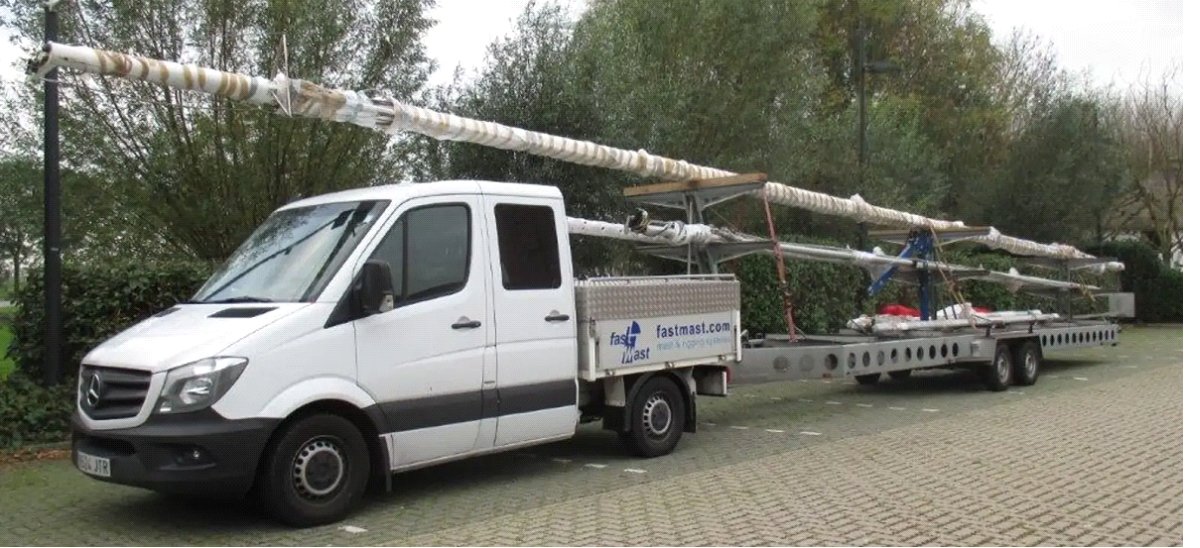 |
The van used by Rainer Petras to carry masts across Europe. |
We now have to prepare the boat and then get used little by little with inland navigation and locks. We already have some experience in inland waterways, but always with our mast standing: the Caledonian Canal and the Crinan Canal in Scotland, part of the Intracostal Waterways inside the east coast of the US (plenty of bridges but no locks), the Kiel Canal that cuts the root of the Danish peninsula, and part of the Staande Maast Route, in Holland, from Lauwersoog to Lemmer: but this is nothing compared with what is waiting for us.
May 25-June 2, 2019: Ecland preparation in Amsterdam
I drive up to Amsterdam with Franco and André, carrying all the stuff I bought in Italy, and we spend together a week setting Ecland for this unusual cruise; Claudio joins us a few days later.
We move from Amsterdam Marina to Twellegea Jachthaven, where they have a crane, to dismast and clean the hull. Dismasting is fine, even if the crane is a bit undersized. We disassemble all possible stuff, and create two long ‘sausages’ wrapped with thermoshrinking plastic, the first one with the mast and all the standing rigging, the second one with the main boom, the forestay boom and the aeolian pole. All the rest goes into the sails store.
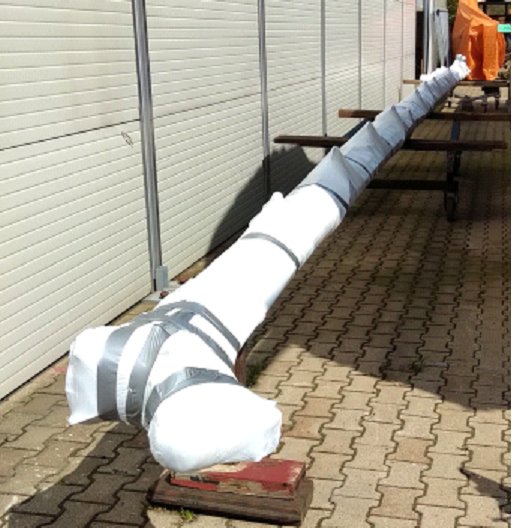 |
The ‘sausage’ with the mast ready for pick-up at Twellegea Jachthaven. It will be in Port Napoléon before we start our summer cruise. |
Back to Amsterdam Marina, we begin working to prepare Ecland for the summer: build a short mast on the deck that holds navigational lights, horn, VHF antenna, and courtesy flag; set new mooring ropes (4 of 20 metres and 2 of 10) for the large locks at the beginning of our journey; add some slim square fenders to be always kept in place for the small locks on French canals, which are slightly larger than Ecland's beam; replace the fridge which died last year; set USB sockets in the cockpit in order to use my tablet with digital charts; a few more repairs on duty from our last cuises; a complete check of our engine; something to rig an awning over the cockpit for sun and rain even without the boom in place; and finally, a couple of used bycicles to be found almost everywhere in Amsterdam.
When we leave for Milan, Ecland is ready. Her total height from the waterline is 3,20 metres, and this is perfect even for the lowest bridge we can meet.
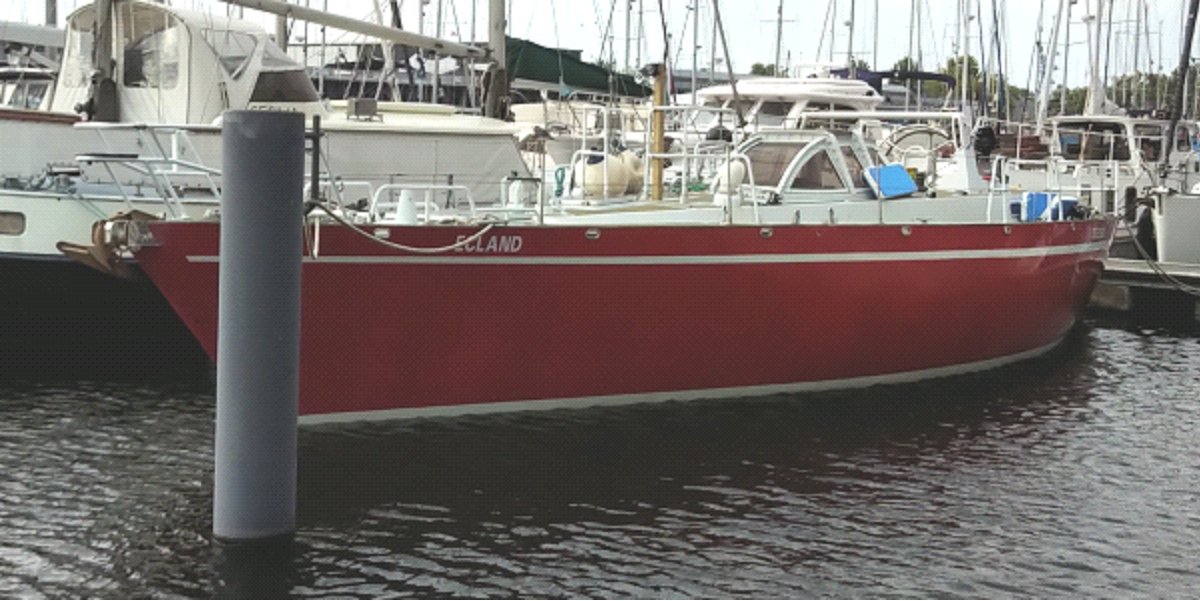
Ecland back to Amsterdam Marina: it's a bit shocking to see her afloat without her mast.
While driving back to Italy, we stop in Auxonne just to see the place where Ecland will be wintering, and we like both the small harbour and the village.
On July 7 Rainer Petras picks up our mast and boom in Amsterdam, and on July 10 he drops them in Port Napoléon.
July 21-23, 2019: Amsterdam
I arrive with Franco in Amsterdam Marina, and we install the new fridge, clean the boat, check our ‘new’ bikes, set and place the new ropes and fenders, prepare the navigation instruments – my tablet in front of the rudder wheel an my laptop inside, linked to a gps, both with the same charts – and make full provisions. On the 22nd André and Claudio are there, and Peter on the 23rd. We are ready to go, we just need to fill up our fuel tanks.
July 24, Wednesday: Amsterdam - Vianen [56 km, 2 locks, 6h]
Departure at 8. The weather is fine and very hot. After a stop for fuel (370 litres), at 9 we enter the Amsterdam-Rijn Kanal (ARK), at Pk 1. Every canal has its own kilometric numbering, with a panel shown each kilometer (Pk in French stays for point kilometrique) numbered from the beginning to the end, in a sense varying from canal to canal and from river to river: rivers are counted bottom-up (i.e. from the mouth to the source) and canals in an independent (and sometimes confusing) way.
Despite the working day, there's no much commercial traffic, but the comings and goings of ferries in front of Amsterdam is impressive.
We proceed at a speed of 5,7 knots (slightly more than 10 kilometers per hour, now we have to get used to consider our speed in km/h, instead of knots).
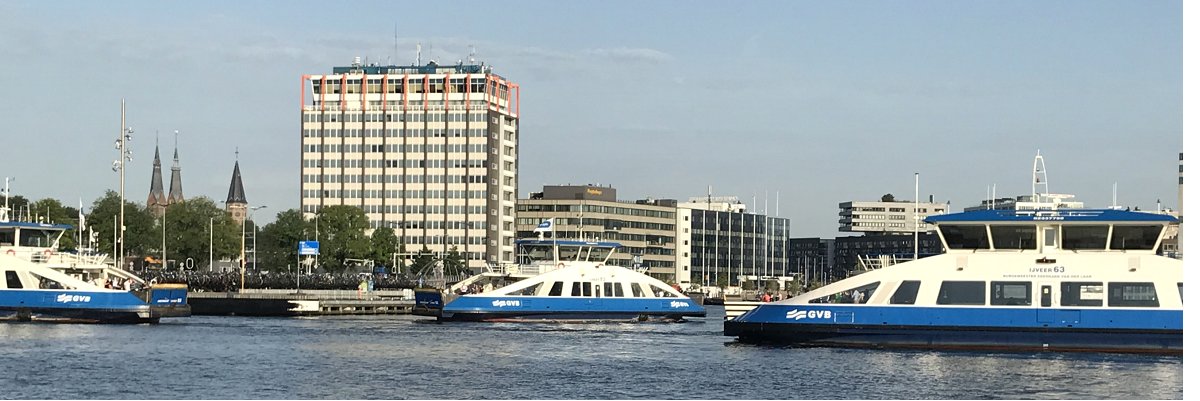
The ferries traffic in the Amsterdam waterfront.
 |
Pk 1 on the Amsterdam-Rijn Kanal. |
In the canal we see any kind of floating objects: from barges of hundreds of tons to kayaks, ropes of small sailing dinghies, improbable house-boats and microscopic tugs turned into pleasure crafts; the power of imagination!
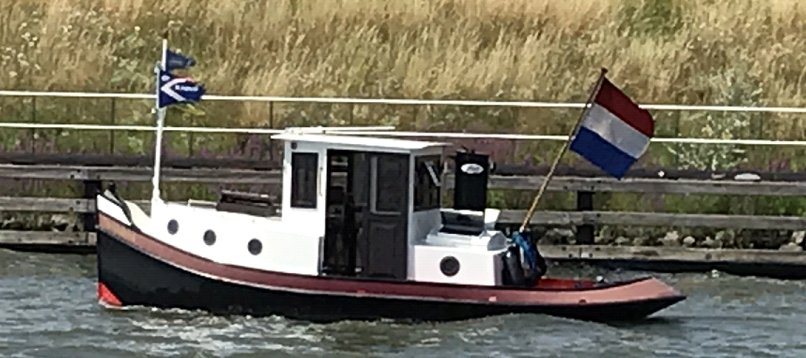 |
The canal people! |
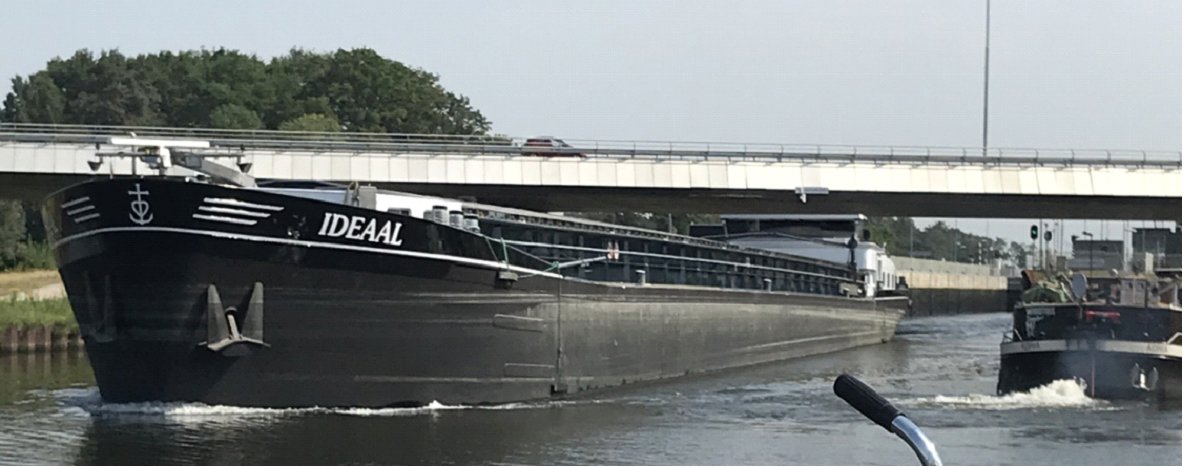 | |
 | |
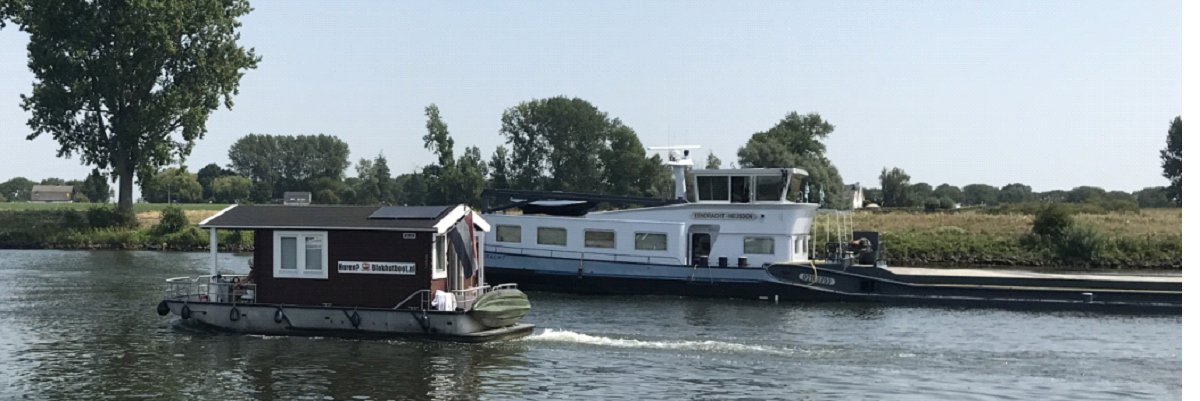 | |
Locks are not going to be time-wasting: 20 minutes at Princes Beatrixsluis, 10 minutes at Grote Sluis of Vianen. By now locks are huge, built for commercial barges, 200 metres in length and more than 20 metres in width and 4 metres in depth when empty. Operators watch from control towers of fancy shapes, and we don't even need to call them on the VHF, as there is always somebody ahead queuing for the passage; commercial barges have priority, and pleasure crafts tie along the opposite wall one after the other: when there is no more room, they tie alongside a barge, as width allows; lock dimensions are such that we don't feel any turbolence. The only thing to pay attention to is mooring: bollards are fixed inside niches in the wall, except the uppermost row which is placed on top, and as you go up or down you have to move your ropes from one row of bollards to another in order to avoid being hanged. The horizontal span between bollards is fit for big barges, not for small pleasure crafts, and we have to work with our ropes passed on top of a gaff, both forward and astern. In Amsterdam we've taken two light and telescopic gaffs for this purpose.
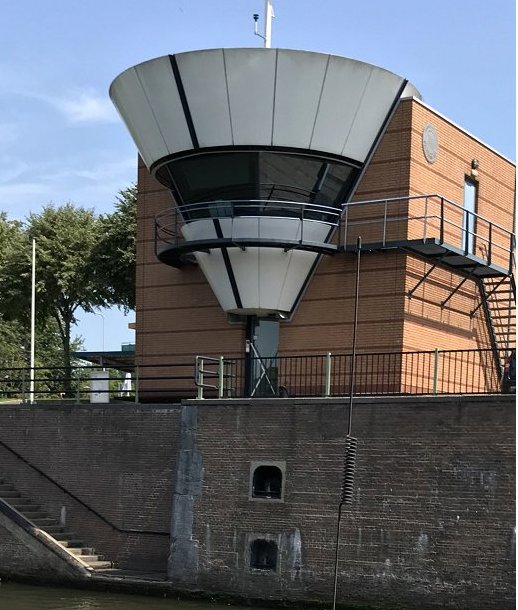 |
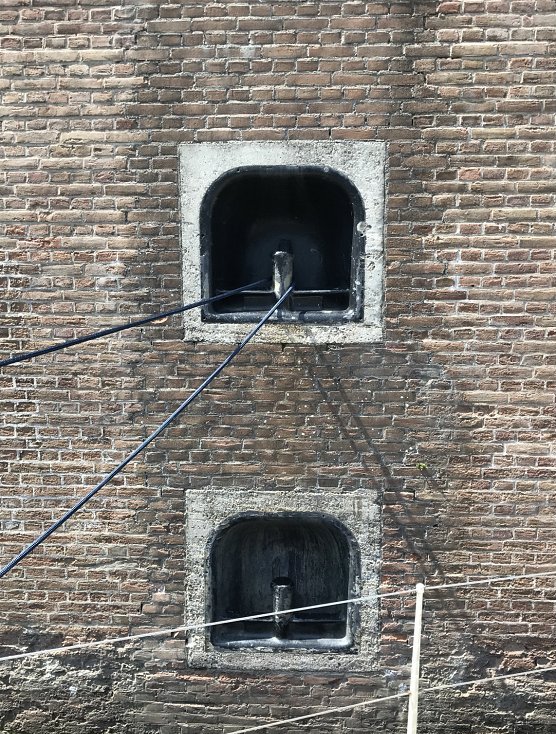 |
||
The fancy control towers of Dutch locks. | |||
At 14 we moor in the Vianen passantenhaven, in the Meerwedekanal. Nice place, but with no resources.
July 25, Thursday: Vianen - Veghel [77 km, 7 locks, 7h30]
We leave at 8:45. We sail back part of the Merwedekanaal and through Grote Sluis, and then we enter the river Lek heading east.
At 12 we are back in the Amsterdan-Rijn Kanal. There is no wind at all and temperatures are awful, near to 40 °C, but while we are running some air created by our speed makes heat tolerable.
We hesitate in reaching ’s-Hertogenbosch, but the opportunity of a shortcut through the Maximakanaal is too tempting. So we go thorugh the St. Andries canal and the Maximakanaal, and at 19 we enter the short side canal leading to the basin of Veghel marina.
I have underestimated the heat: once stopped, I feel the consequences of a heat-stroke and of dehydratation, with cramps everywhere, expecially in my legs. A cool shower gives some benefits, but I have to spend the night on the deck, as I cannot lie down for more than 30 minutes without getting up due to the cramps. I have to pay much more attention, drink a lot of water, and swap the tiller more often!
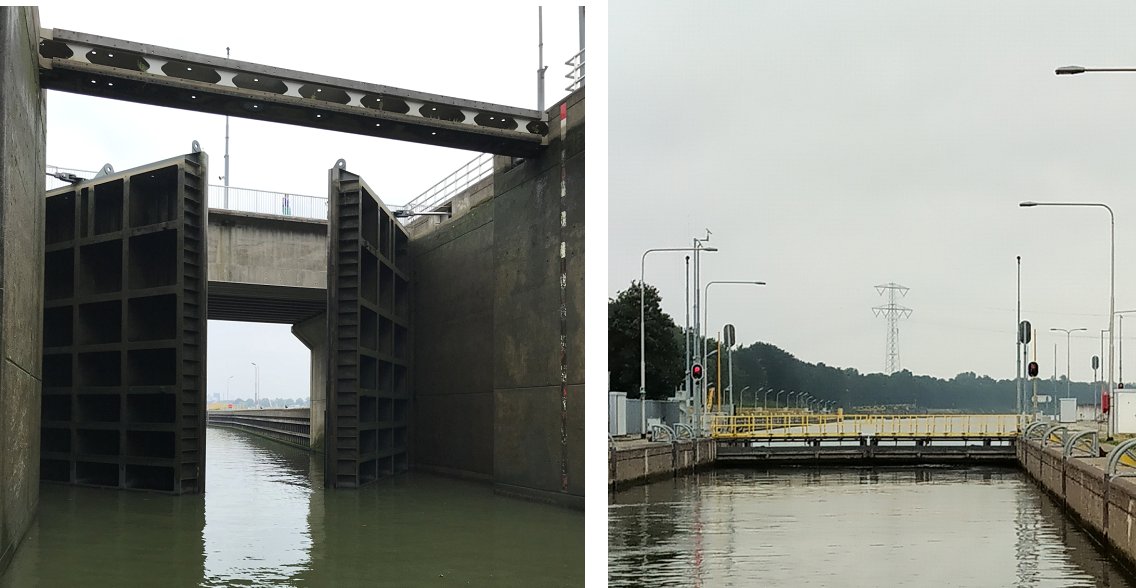
The large Dutch locks going upstream, just after going in, and just before getting out.
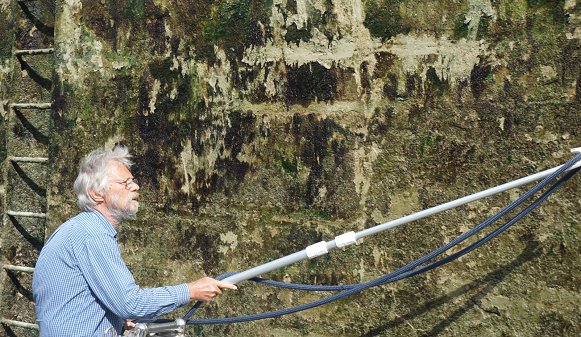 |
André handling the mooring with the rope running on top of the gaff to reach the bollard. |
July 26, Friday: Veghel - Maasbracht [63 km, 9 locks, 4 opening bridges, 9h]
This morning I already feel better, even if I didn't sleep much, but I keep a bottle of water at hand. We leave at 8:45 proceeding southwards. At 13 we enter the Zuid-Willemsvaart, lined by trees beyond which we see miles of cultivated fields and pastures. Our mooring technique inside the locks is improving quickly.
Inland waterways are well indicated, using a signal code shared by all Countries, with a number of signals that makes the rules of the road a child's play if compared. Beside the convention that right and left banks are always relative to the downstream direction of rivers and canals, also red and green buoys follow the same rules, and therefore they change from canal to canal; we have signals for the correct passage under bridges, signals for restriction of draught, width, height (not our concern), obligatory direction around islands or obstacles, etc. The CEVNI guide (the European Code for Inland Waterways), that you must carry on board, is a bundle of 200 pages!
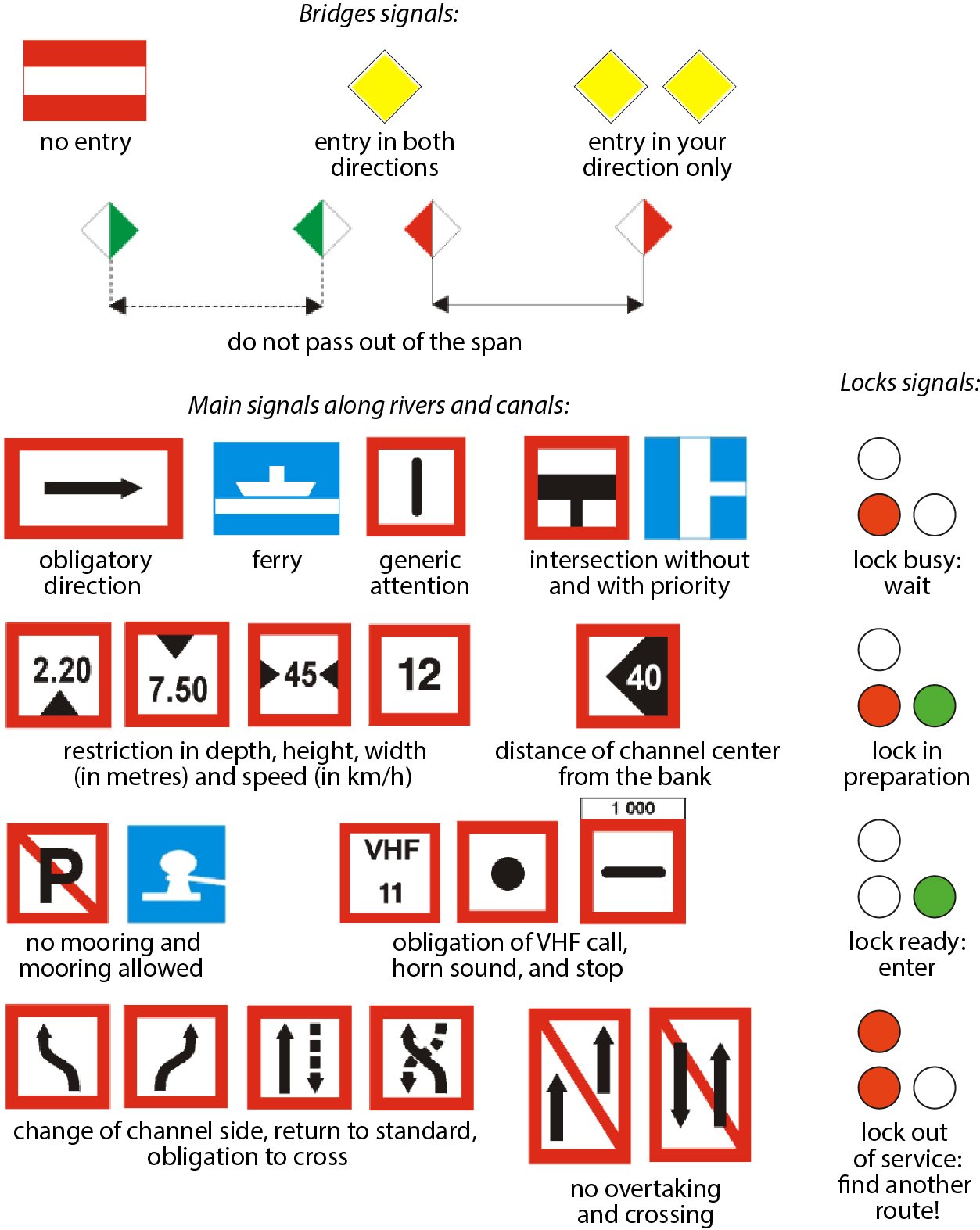 |
The main CEVNI signals. |
At 17:45 we moor at the jachthaven Van den Laan in Maasbracht. Temperature is falling and the weather is getting worse. Shower is going to be hot tonight.
July 27, Sunday: Maasbracht - Maastricht [41 km, 2 locks, 5h30]
Departure at 10 towards Maastricht, where we have a rendezvous with Yvonne. Inside the Julianakanaal we pass the Maasbracht lock, the deeper up to now: 21 metres of fall. We arrive at 15:30 in the ‘t-bassin downtown Maastricht, where we are going to stay for two days: it rains. Facilities are wonderful, even if we need to join together three pipes to make water, as the tap is 50 metres away, below the bridge.
 |
Navigation along the Julianakanaal. |
July 28, Sunday: Maastricht
Stop in Maastricht, with a walk around the town, in particular the Vrijthof square, the churches of Saint John and Saint Servatius, and the Market square. A stop in Boschstraat, with one of the most ancient breweries of the region, is due. Once back on board, some technical checks: engine oil, fuel decanter and raw water filter, where we take 5 cm of weed and green slime out. At 18 Yvonne arrives. It's raining the whole day.
The after-effects of the heat-stroke have completely gone. We make full provisions, with some difficoulty in finding an open supermarket on Sunday.
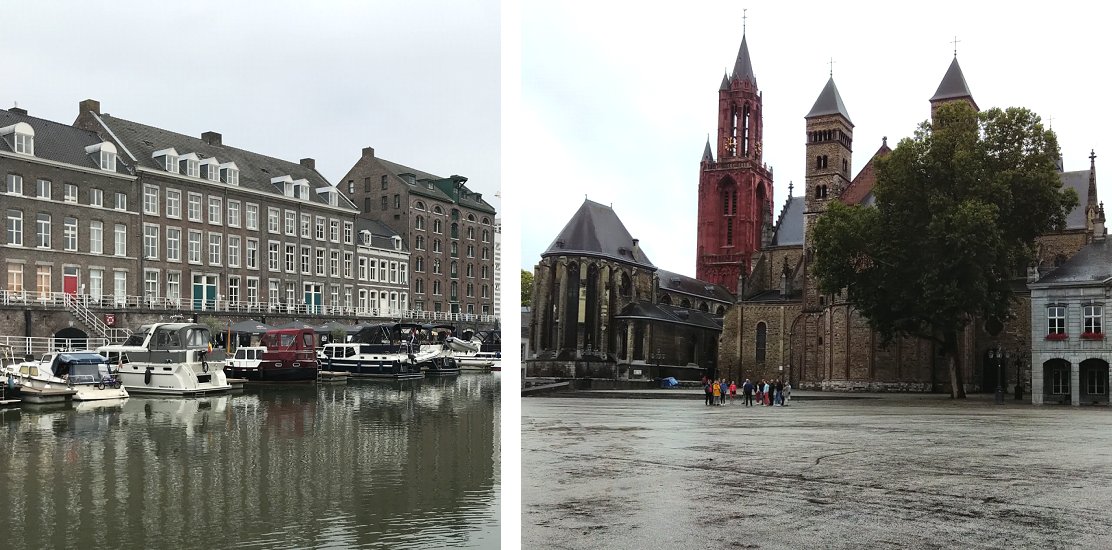
The ‘t bassin in Maastricht and Vrijthof square.
July 29, Monday: Maastricht - Liège [28,5 km, 1 lock, 4h]
We leave at 9:40. At 11 we pass through the Lanaye lock, marking the border between Holland and Belgium, where we wait some times for the arrival of a big commercial barge. Inside the lock, much more traffic than usual, mainly of small motor boats. We enter the river Meuse river: the sun is shining again and temperatures are fair.
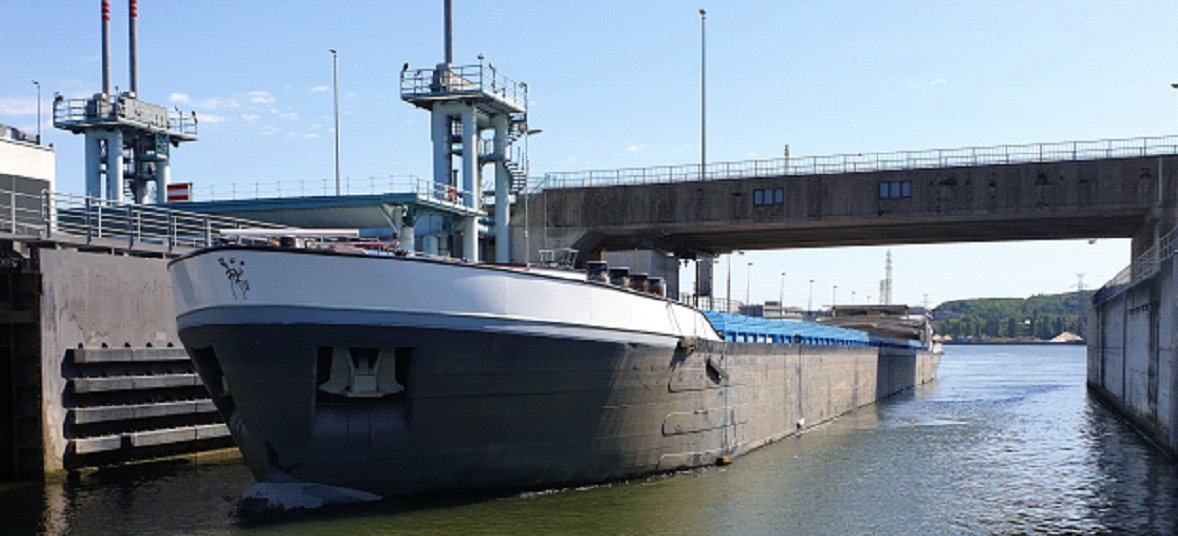 |
Waiting for the barge at the Lanaye lock. |
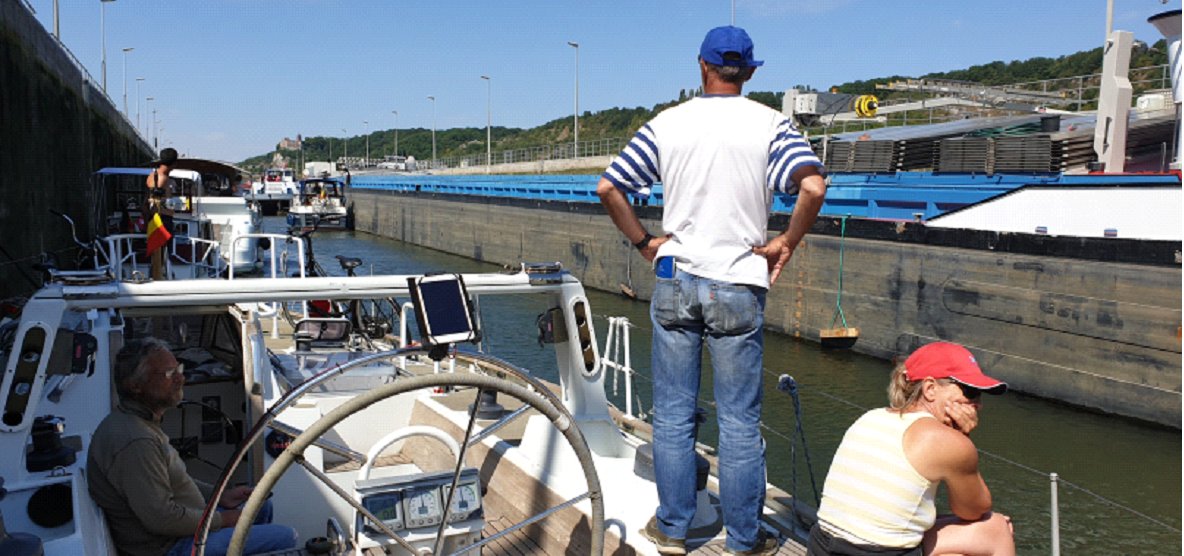 |
Never seen so many boats! |
At 13:30 we get into the basin of the Port des Yachts of Liège, tying up to the last place on the quay which is long enough for us. Good facilities. Tour around the town, nice but without overdoing. On the other hand, we have entered the kingdom of the beer! There are more breweries than people around, and the white Belgian beer or the trappiste you can find here are excellent!
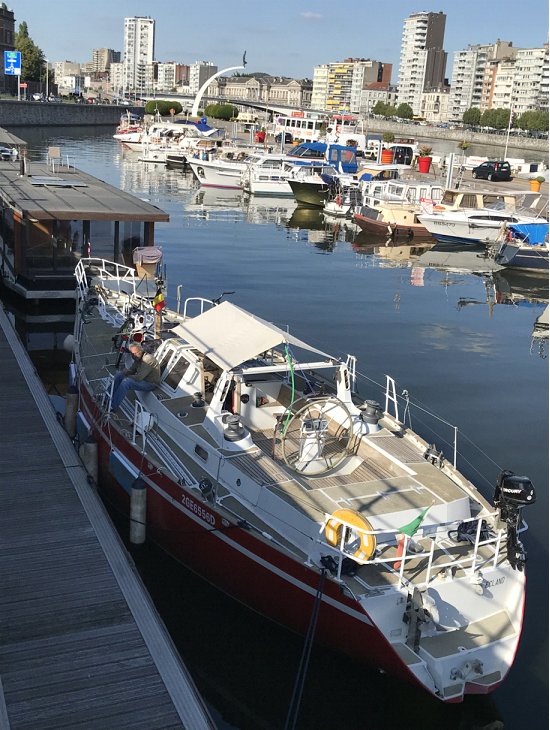 |
In the Port des Yachts of Liège. |
We begin feeling the French influence even in food shops: in this fromagérie we will spend a fortune! | 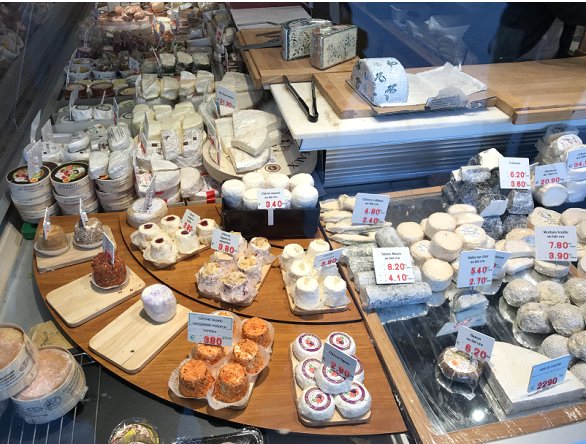 |
.
July 30, Tuesday: Liège - Huy [34,5 km, 2 locks, 5h30]
Departure at 9:30, with difficulties with our batteries in starting the engine. It is better not stopping the engine inside the locks today, and afterwards we’ll make a check once moored. We wait 30 minutes at the Neuville lock.
At 15 we come to the basin of the small harbour of Huy, that looks too small for us, and we cannot see how is it inside because of the high wall. We don't trust in getting in without knowing how it's fitted, as there could be not enough room for us to manoeuvre, and we let go ahead a small Danish sailing boat. We stop bow to the outside of the wall and climb on it to have a better look, and we see a fine spot alongside the inner side of the wall, just after the entrance, so we move there.
We tight all electrical connections on the batteries, the distribution frame and the starter: the problem seems to be solved and the engine starts at first turn. We have dinner outdoor at the small harbour restaurant, which is very pleasant.
July 31, Wednesday: Huy - Namur [30 km, 2 locks, 5h]
Departure at 9:30 towards Namur, where we are going to stop one more day. Today the two locks are a bit time-wasting. At the lock of Grands Malades, just before Namur, we take alongside a smaller Danish sailing boat, as there is no other room.
At 14:30 we tie up to a finger in Port de Jambes of Namur. We have finally convinced our speedometer to think in kilometers, and this is of great help. The harbour master tells us that lock n.7 south of Namur is out of service, and that he will know some more details tomorrow.
We meet Per and Mette, of the sailing vessel La Cane, the Danish boat met inside the lock of Grands Malades (and even before in Huy), and we share with them our concern with the possible delay: we will see tomorrow. The weather is cloudy but it doesn't rain.
Namur is about 40 km from the French border, at the intersection of the river Meuse and the Sambre: we climb up to the citadel on the opposite bank of the Meuse, from where we dominate the entire town and both rivers.
My crew is behaving very well: even it is true that while sailing there's not much to do, when manoeuvring everybody knows what to do and became good in managing the lock passages. My greatest fun, every evening, is always planning the journey for the day after, with charts and guides. Ashore, everybody goes wild walking.
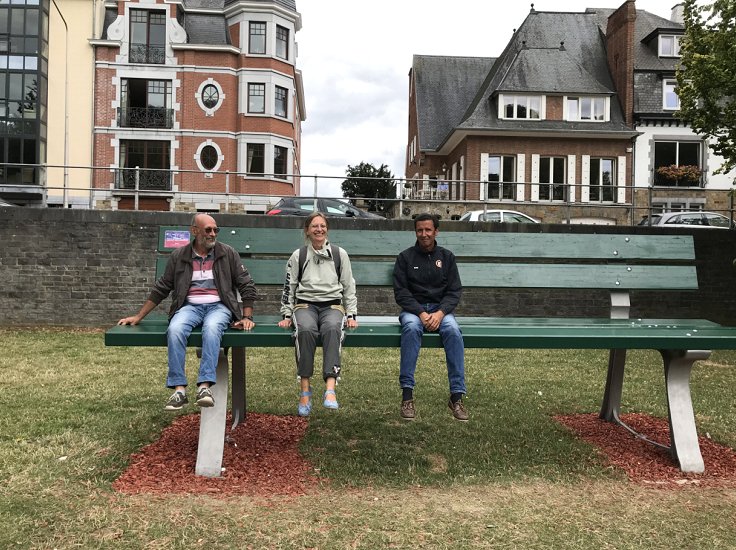 |
In front of the Port de Jambes in Namur, a giant bench where everybody looks like a dwarf is of great fun! |
August 1, Thursday: Namur
Very bad news: lock n.7 south of Namur is really broken, and they don't expect to fix it before Tuesday 6. But the greatest problem is that, because of the drought, the canalised Meuse has been closed to navigation half way between Sedan and Verdun, some 100 km to our south. I make a phone call to the VNF staff (Voies Navigables de France, the agency that operates most of the French inland waterways) and a lovely young lady confirms that not only the Meuse is closed south of Sedan, but also most part of the canals throuh Burgundy, like the canal de Bourgogne and expecially the canal des Vosges that we planned to sail, are closed to navigation due to water shortage: in other words, our planned journey is not possible any longer.
We plunge in our documentation and try to find out an alternative route: we have on board digital charts for the whole France, and also the Cruising Association guide covers all Belgian and French inland waterways. Namur is placed in a special position in order to change the route, and in fact there is an alternative to avoid being stuck here, making a long detour westwards along the rivers Sambre and Escaut, then southwards along the canal de Saint-Quentin and the river Oise, and finally eastwards going upstream the river Seine up to Paris.
I try to get informations on the Internet about the chance to find a wintering place for Ecland in the Paris area, and send an e-mail to Vassili at H2O telling him about the change of plans and the fact that most likely we won't be able to get to Auxonne. In any case I have to be back in Milan by Monday 2 September at the latest.
In the meanwhile we fill up our galley and our water tanks. Fuel is not going to be a problem: we've run for 45 hours till now, consuming about 180 litres, and our tank holds 400 litres.
Claudio, Yvonne and Peter, who were supposed to get off between the 5th and the 10th, begin investigating their change of flights: for them we need to make an accurate planning.
During the afternoon Vassili answers with an e-mail that gives me some hope again: he writes that, if we manage in getting to Paris, we may then sail upstream the river Marne and its lateral canal, and then down the canal entre Champagne et Bourgogne, that at his knowledge is open, with a granted depth of 1,7 metres, and remains the last navigable waterway to cross central France. I call back the VNF staff and they confirm this possible route, so the decision is taken and by now I discard the option of ending our cruise in Paris.
We talk with the crew of La Cane: they are carrying their mast on deck, and were already thinking about going back to Antwerpen, remasting, and getting out at sea; their original plan was to go down to the Mediterranean and slowly sail until the Canary Islands, before making a U-turn and sail back to Denmark in 2020.
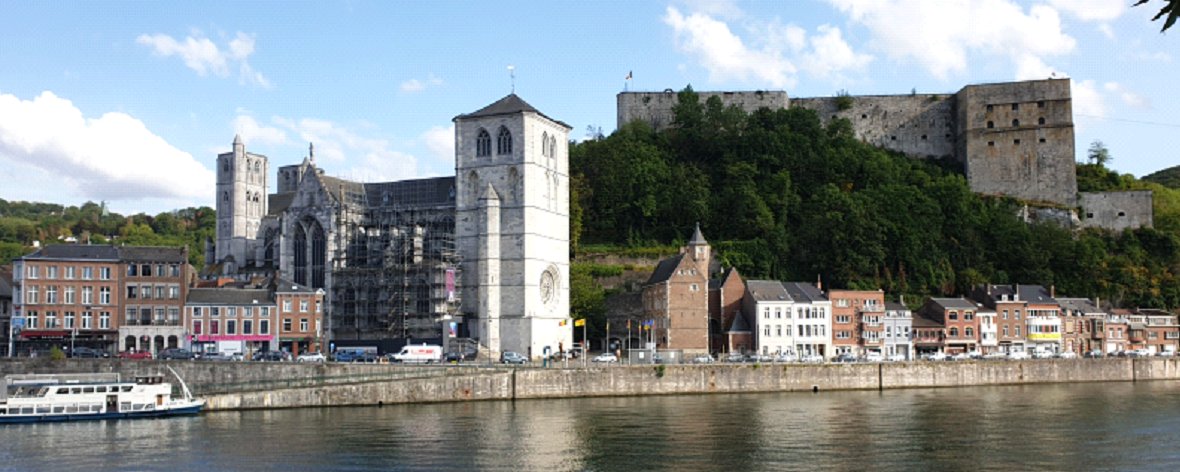
The citadel of Namur from the river Meuse.
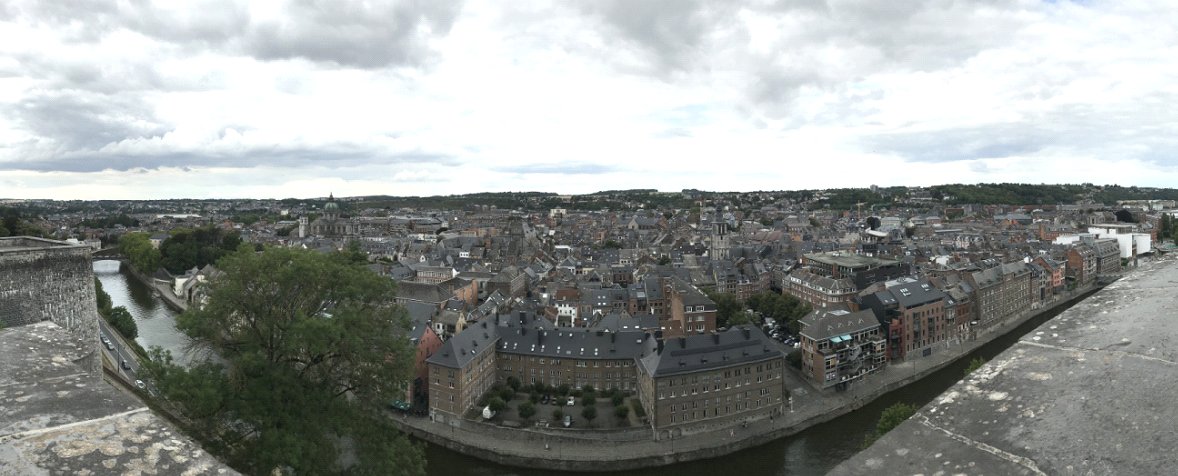
The town seen from the citadel, on the Sambre side ...
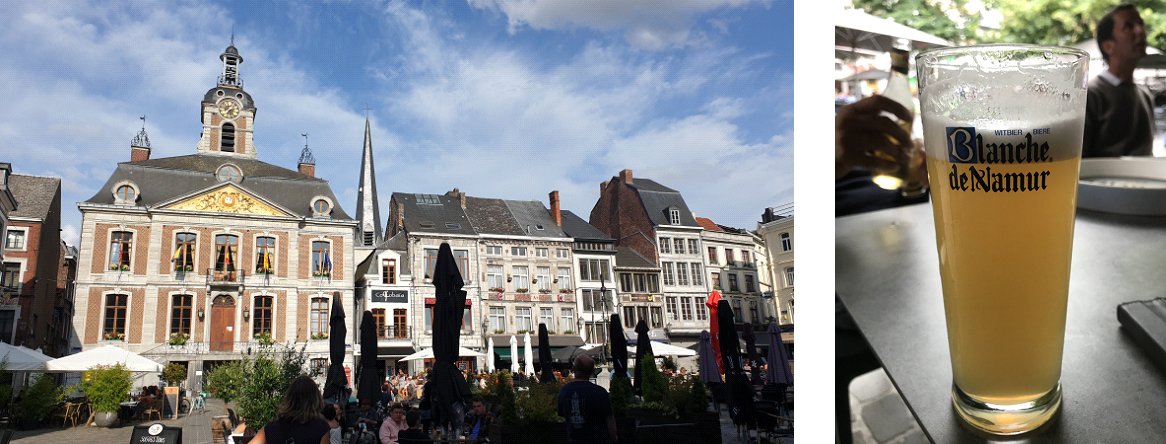
... and seen from the table of a bistrot.
After we've told them about our new plans, Per and Mette, whose French is approximate and don't carry detailed charts for the new route, ask us if we agree in making the route together, following us wherever we go. Of course we agree! We explain that it won't be a cruise of total relax, as we have a longer journey with the same schedule, and we have to deal with the locks timing for pleasure crafts, which is from 9 to 19, with night sailing forbidden.
In addition, the planning has to be exact: at the passage on the top of the hill in the canal de Saint-Quentin there is a tunnel (as everywhere when you pass the top of a hill from upstream to downstream, to guarantee the water reserve for the topmost locks), indeed there are two tunnels here, and in the Riqueval tunnel, 6 kilometres long, it is forbidden to run under power: all vessels are towed on the same line by an electric tug, that must be booked in advance. Finally, there is only one place to stop in Paris, as we are not allowed to tie up to the berges: this place is the bassin de l’Arsenal, downtown behind the Bastille, and it may be full as a tick on mid-August holidays.
Per and Mette agree, and we decide to leave tomorrow morning. We also have to pay attention to the draught of La Cane, which is 1,7 m, 20 centimetres more than Ecland, and in the current dry season this is a bit short for the Champagne-Bourgogne canal; but Per and Mette know what is waiting for them (and we as well) and are not much worried to drag a little, if this means getting to the end. We hope for the best. We make a tour downtown looking for paper guides of the river Marne and the Champagne-Bourgogne canal, just to have some more informations, with no success.
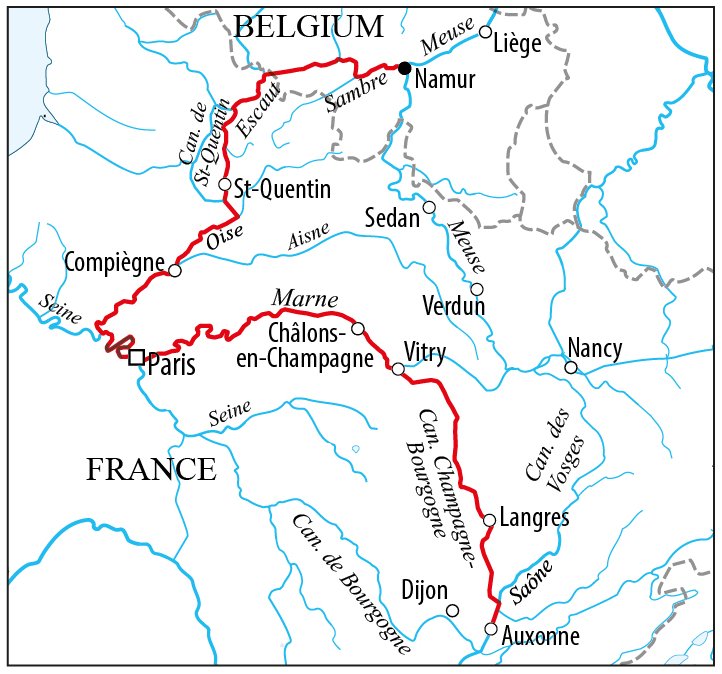 |
The new route from Namur to Auxonne: |
August 2, Friday: Namur - lock of Viesville [59 km, 9 locks, 11h]
We leave at 8:30 and enter the river Sambre, in train with La Cane, with a Dutch motor boat and with a Belgian barge that opens our way through the locks, as commercial traffic has always priority. Locks become to increase in number now: we are running at the maximun allowed speed on canals. At times we look behind to check if La Cane is always following, but they have no problems in mantaining our speed, between 9 and 10 km/h.
In Charleroi we leave the river Sambre and enter the canal from Charleville to Bruxelles, in a scenery spangled with old disused factory buildings, a haven for industrial archaeology lovers, like Yvonne. La Cane takes a plastic bag into her propeller, but after a few manoeuvres gets rid of it.
Back into the countryside, at 19:30 we stop on the right bank, just before the lock of Viesville, already out of service for today. This is our first stop in the middle of nowhere, tied up directly to the green, with no lights during the night and no noise, that are an unforgettable memory.
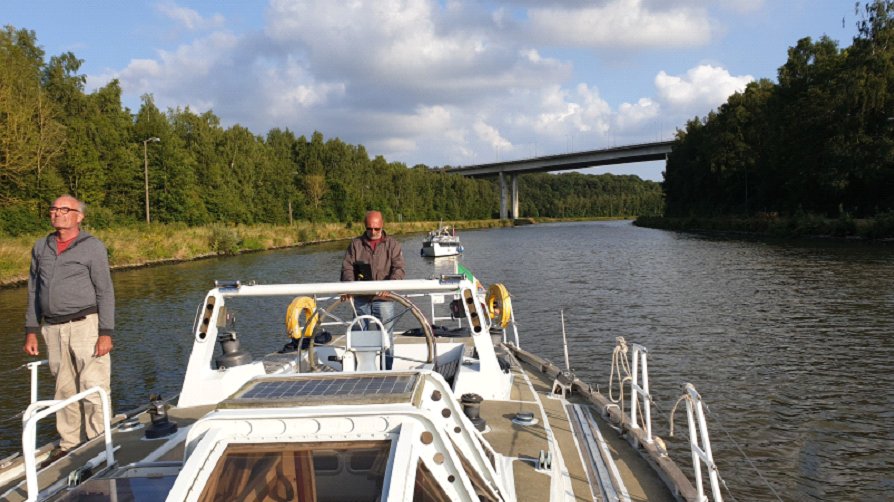 |
On the river Sambre, in train with La Cane. |
The abandoned building in the Charleroi outskirts, along the canal between Charleville and Bruxelles. | 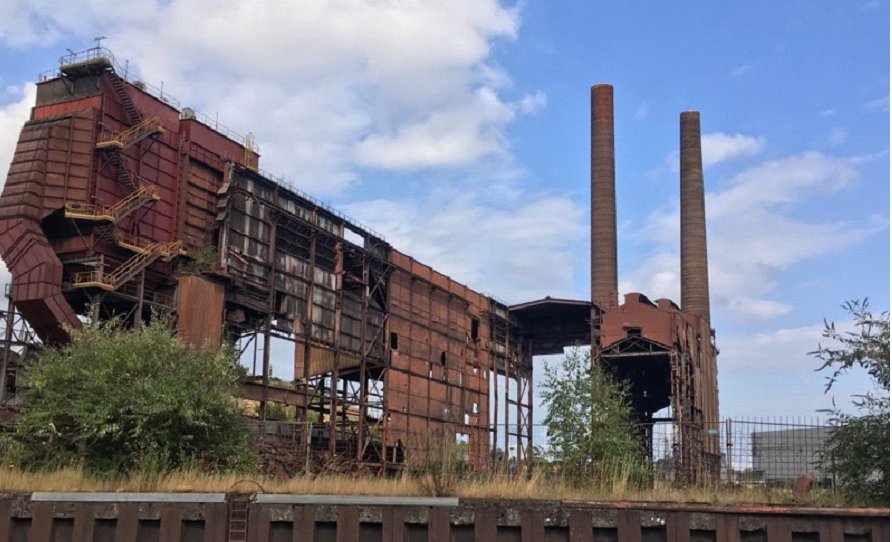 |
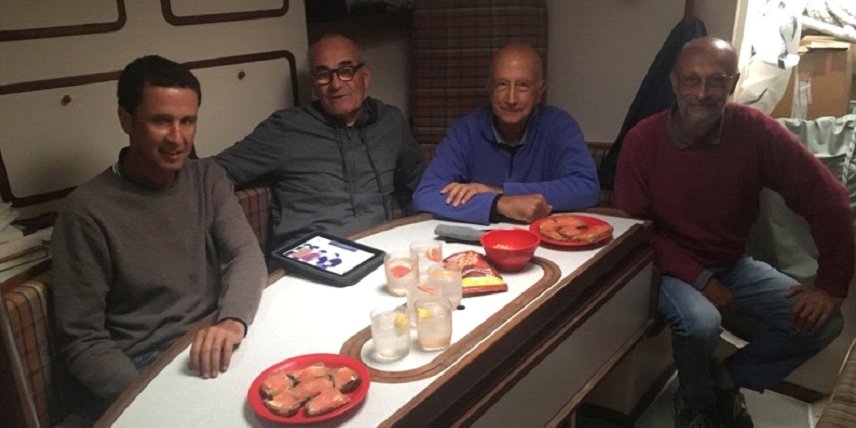 |
At the end of our daily ‘hard work’, aperitif time: gin and tonic and salmon canapé. |
August 3, Saturday: lock of Viesville - Péruwelz [68 km, 4 locks, 1 lift, 10h]
Departure at 8:30, with the first opening of the lock which is just ahead. At 10:30 we enter the canal du Centre and after a few miles we sight from far away the tower of the Strépy-Thieu lift, an engineering work that allows boats to make a jump of 73 metres, really impressive!
You get into the lift chamber like a lock basin, and the entire basin goes up and down with its content of water and boats.
We moor at 11:30 at the waiting dock and make a tour around the installation, as we have to wait for the second lift, the first one being entirely filled by a big barge. The lift operation itself lasts just half an hour, but with the time spent waiting for the lift, getting in and going out, it is finally a 4 hours job.
 | |
The tower of the Strépy-Thieu lift, well seen from a long distance. | |
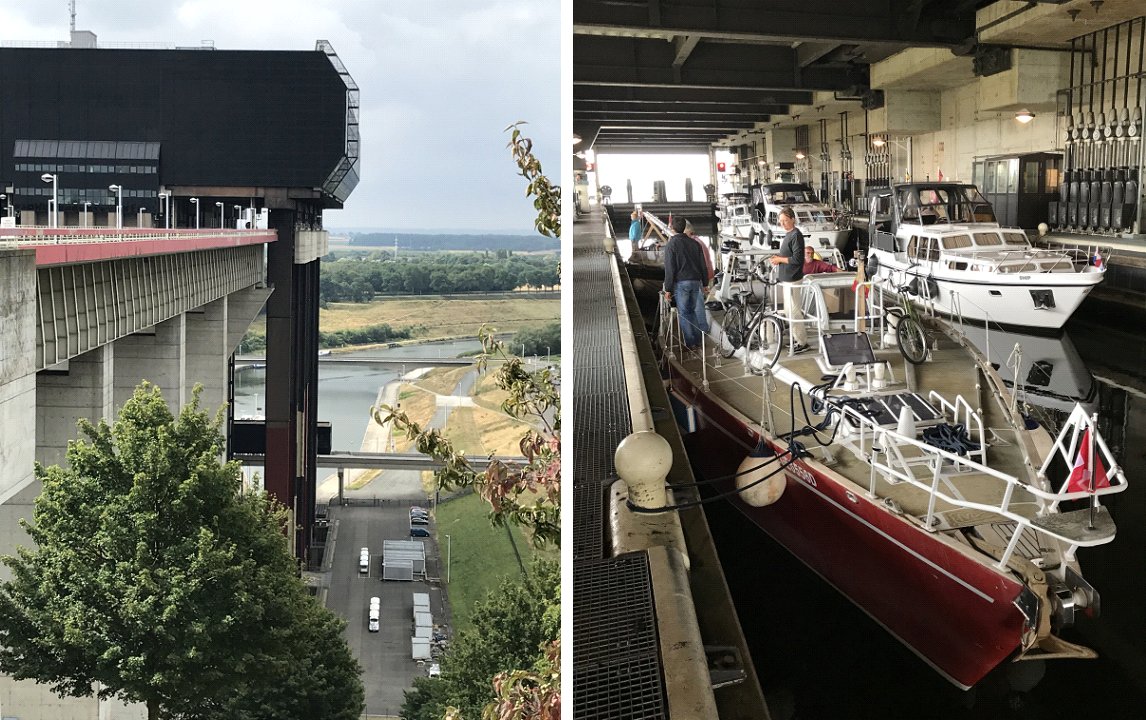 | |
The 73 metres jump seen from the top. |
Everybody in, ready to go down. |
After getting out from the lift chamber and passed the last two locks of the canal du Centre, at 16 we enter the Nimy-Blaton-Péronnes canal. We make a phone call to check if there is place for us in the only possible harbour, and at 18:15 we get into the small bassin du Moulin in Péruwelz, with La Cane alongside Ecland. Before it gets too late, we book for the passage through the Riqueval tunnel for Thursday 8th.
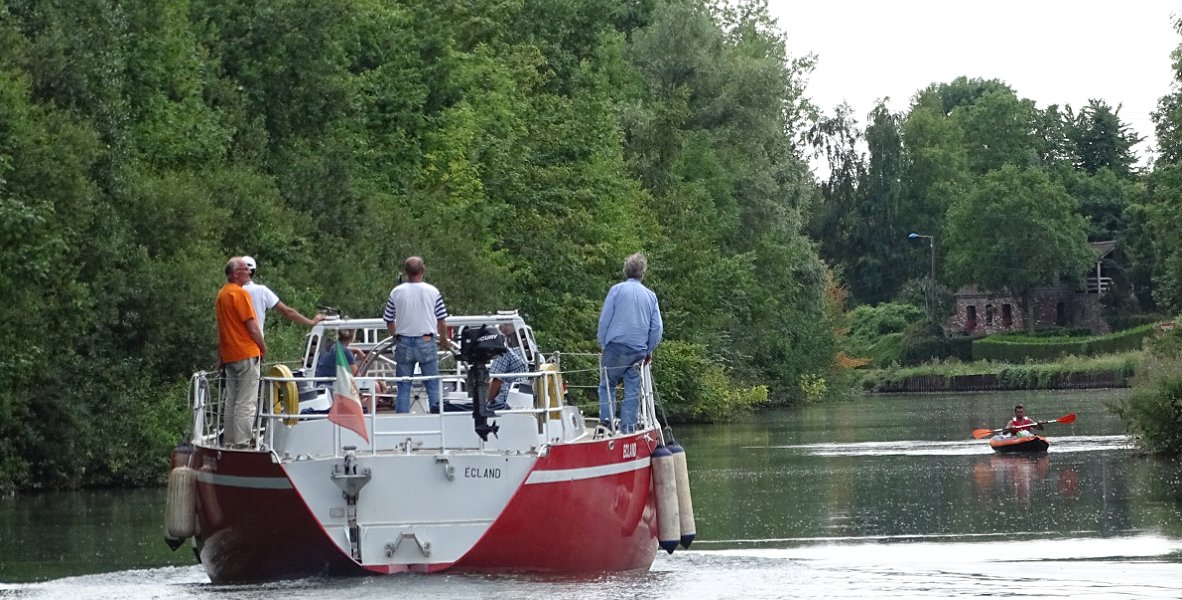
Along the river Escaut.
August 4, Sunday: Péruwelz – Cambrai [77 km, 13 locks, 10h]
Departure at 9. At 10:40, passed the twin locks of Péronnes, we enter the river Escaut, and half an hour later we are in France, passing aside of the old and derelict customs station.
Today is an eventful day. After the lock of Pont-Malin, the last one in the upper Escaut, we turn into the lateral canal of l’Escaut and when we try to get into a cove called Bassin Rond for an overnight stop, we get stuck in the mud over 1,2 metres of water. In half an hour, playing at full power ahead and astern to dig a channel in the mud, we hardly get out and proceed southwards looking for an alternative stop.
At 18 we get to the Iwuy lock, which is the first one where we need a remote control in order to pass, but it's a bit late and it's a Sunday. We moor just before the lock on the grass bank in a precarious position, and try anyway to call the travelling lock operator (itinérant in French) from the intercom inside the lock: the guy arrives in 15 minutes!
As he was going home, he suggests to go further south, down to Cambrai, passing the last 4 locks with him going ahead with his van, in order to open the locks before we arrive and save time, as all locks has to be closed by 19; he also lets us understand to forget any speed limit and push on the gas handle: when we offer him a beer, he smiles and answers that there are too many webcams around!
So, running at full speed (12 km/h), with the operator ahead and all locks already open, we make the last kilometres. Locks are getting smaller and smaller.
The operator asks us if Ecland and La Cane are always sailing together, and after our positive answer, he gives us one single remote control, telling us to pay attention not to leave too much room between the stern of Ecland and the bow of La Cane both entering and exiting the locks, in order to let the photocell think that there is one single vessel manoeuvring. At 19:15 we moor in the nice little harbour of Cambrai, tying up to a couple of trees, as along the only quay long enough for us there are no bollards.
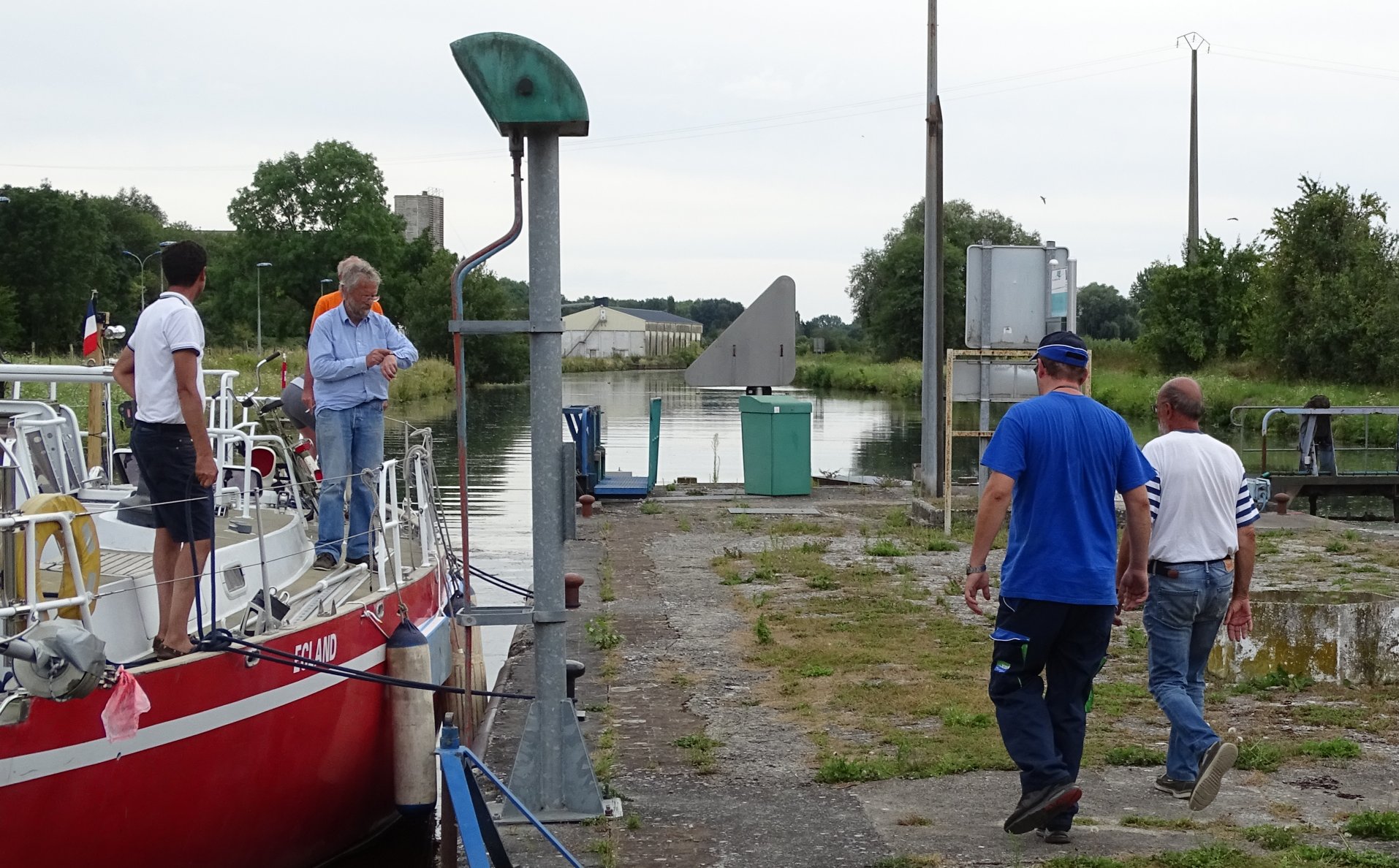 |
Deciding what to do with the itinérant of the Iwuy lock (with the blue T-shirt). André is puzzled looking at his watch. |
August 5, Monday: Cambrai
We stay in Cambrai to rest and make provisions, as Claudio and Yvonne will leave the board tomorrow. Tour downtown, check of engine oil, water filter, etc. We take advantage of the stop to book via the Internet a mooring for Ecland and La Cane at the bassin de l’Arsenal in Paris for the 14th and 15th of August, and as the booking is confirmed, we call Giorgia, who should arrive somewhere around mid-August, and tell her to come to Paris.
We make full provisions, fill our water tanks, showers galore; again, our search for some guides of the river Marne and the Champagne-Bourgogne canal is unsuccessful, and finally I call my partners Marco and Rossella, who are in Paris at the moment, asking to find them there. In the evening we have dinner on Ecland with Per e Mette, who did notice our aperitif habits and arrive with a bottle of gin.
Starting from the Iwuy lock passed yesterday, locks will now be very small, with few exceptions, following the Freycinet gauge: 5,06 m in width (Ecland's beam is 4,56), 38,5 m in length (likely to host Ecland + La Cane with some spare room) and, theoretically, 1,80 m in depth, but this will vary depending on the water shortness.
Here is how it works: at each side of the lock there is a triangular traffic lights, holding three lights: two red and a green light. Green alone means that you can enter (and therefore the gate is already open for you); one green and one red mean that the lock is getting ready for you (emptying or filling depending if you are going upstream or downstream); one single red means that the lock is busy (normally because there's somebody coming the other way); and finally two red lights, which mean that the lock is out of service, and which we hope never to see. Locks are almost always unmanned, and you operate them with a remote control to ask for the opening, or with a long perch hanged in the middle of the canal one hundred meters before, that you have to twist in order to get the same effect. Once inside the basin, you launch the ‘bassinage’ (the operation of closing the entry gate, filling or empying the basin, and opening the out gate) with the same remote control, or more often lifting a blue pole placed on one of the basin’s walls: the red pole just aside is used to ask for the help of an operator in case of troubles (but in such cases a telephone call is more effective). As per low bridges that need to swing or lift, everything works in the same way.
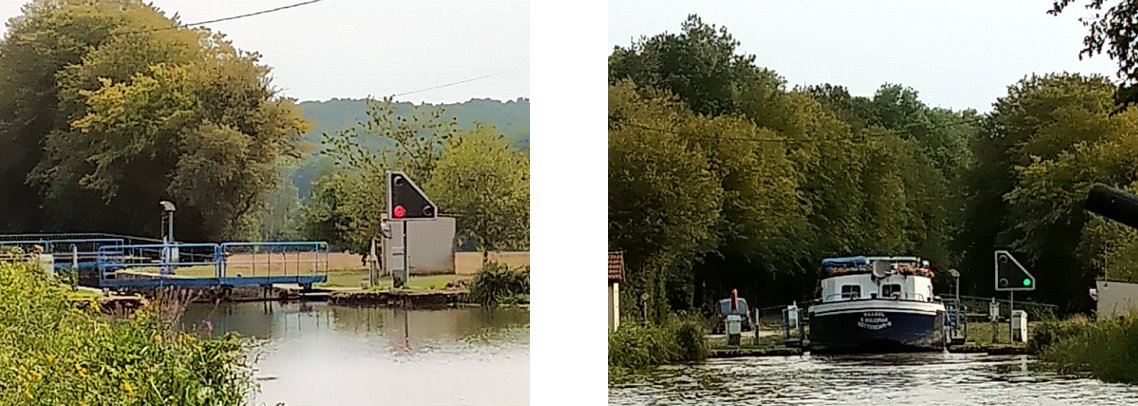 | |
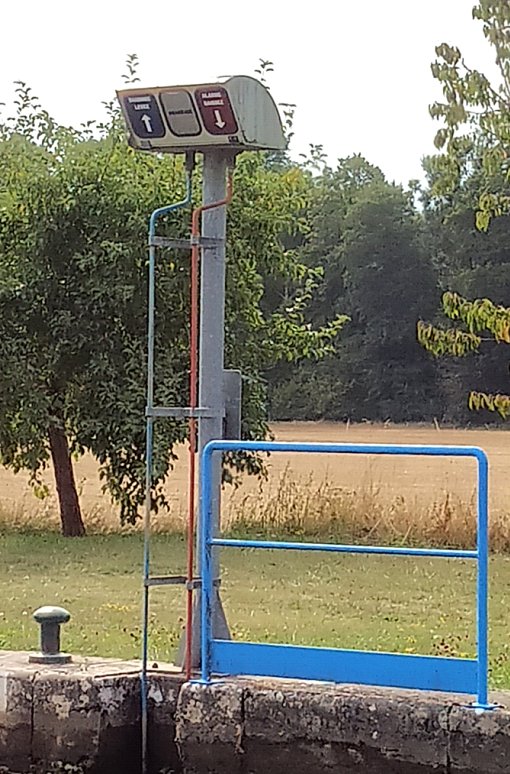 |
Top left, busy lock; right, lock ready (ready just for the barge, that is going to fill up the entire basin). |
Left, the poles used to operate the bassinage: never touch the red one! | |
August 6, Tuesday: Cambrai - Vendhuile (Riqueval tunnel) [27 km, 17 locks, 6h]
Early in the morning Claudio and Yvonne leave the boat. We fill up with fuel (185 litres, and this means that we are burning something less than expected). While waiting for the fuel pump we talk with Svein Bruseland, on a Norwegian sailing vessel of the same size of Ecland, who made in the opposite direction the same route we are going to do, without troubles and with a draught of 1,8 m. We are more confident now. We lend him our detailed charts of the Dutch canals, with promise of mailing them back at the end of the cruise.
We finally leave at 10. No problems with the locks and the single remote control, even because we get in at a snail speed, due to the small margin in width; once inside, Ecland and La Cane fill up the lock also in length. At 16 we arrive in Vendhuile, just before the entrance of the Riqueval tunnel, with the aim of anticipating by one day our booked passage. On the phone I find only and automatic answerer, and from a panel on the bank I learn that the tug makes one single journey per day in each direction. We will see tomorrow morning.
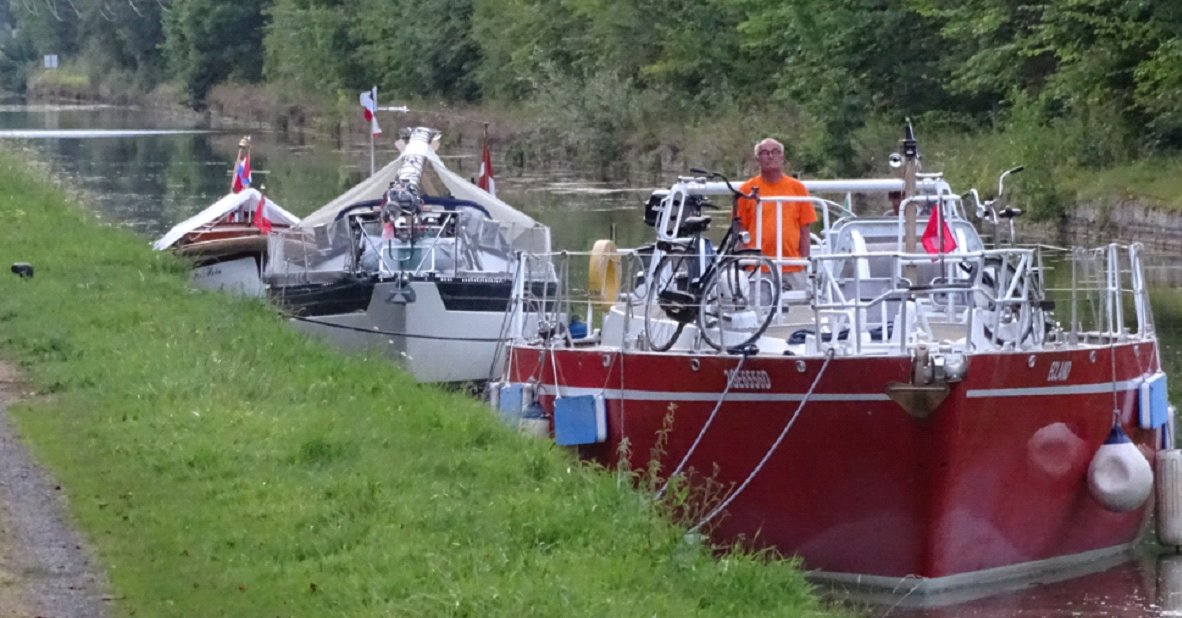
Waiting for the trolley tug in Vendhuile: there will be 4 more clients.
August 7, Wednesday: Riqueval tunnel - Saint-Quentin [26 km (of which 7 towed), 5 locks, 2 tunnels, 7h]
At 9 o'clock, clanking and rattling, our trolley tug comes: it is a bifront barge that moves weighting from the bow a chain than usually lies on the bottom and letting it down from astern, thanks to an electric engine that takes the power from the wires on the roof of the tunnel. The crew is friendly and informal, and will tow us across today. We are going to be the first in the queue, as we are the biggest of the 7 boats waiting, and the tug tows all 7 boats in order of length and weight. For half an hour we work placing all vessels in the correct order, under the survey of the tug's crew. When we ask them how should we pay for the passage, they answer that it's not their business, and we will receive an invoice from VNF at the end of the cruise!
We are actually all registered, as if you want to sail along the French waterways, in opposition of the Dutch and Belgian (Wallon) canals, the VNF asks for the payment of a ‘vignette’ (just like on the Swiss motorways), and our data has been entered in a database that is always checked by the VNF: the vignette costs about 185 euros for one month for a boat of 15 metres, and it's definitely worth the expense, as the VNF operators will be our guardian angels thorughout the whole French section of our journey.
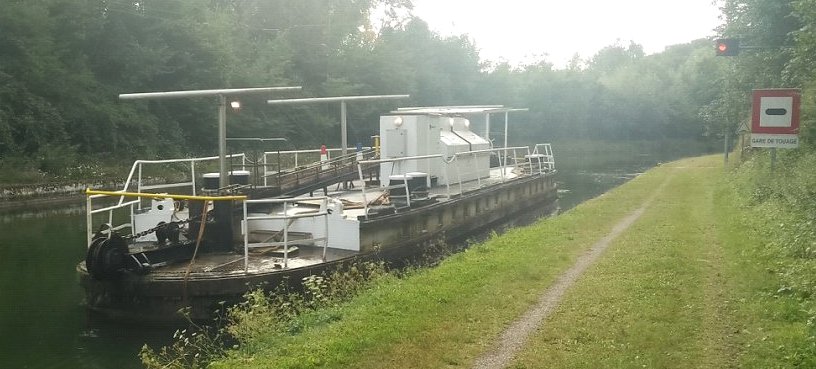 |
The electric tug. |
Inside the Riqueval tunnel, towed by the trolley tug. | 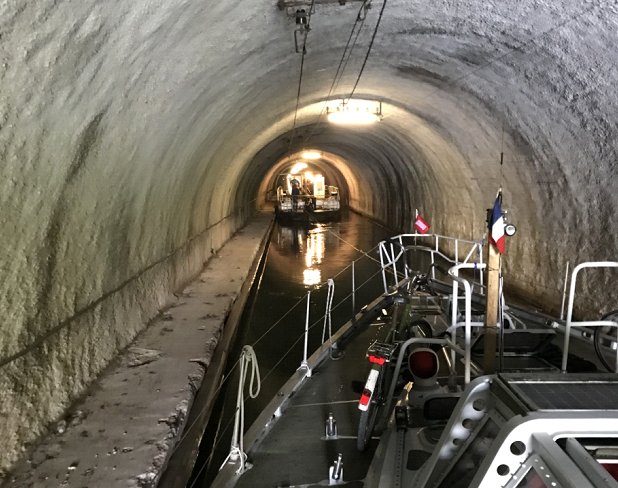 |
We start at 9:50, with some troubles in keeping a straight course, as the 6 boats behind pull us on the side, each one in a different direction. It is cold in the tunnel, and the trolley tug runs at the incredible speed of 2 km/h!
We finally see the light again at 12... but just to stop at 12:50 waiting for the green light of the Lasdin tunnel, the second one (actually waiting for the operators to finish their lunch).
Out of the second tunnel, we discover that in this section of the canal it's not possible to get into the locks in two boats with one single remote control, and therefore the operator at Iwuy was wrong. We get in touch on the phone with the VNF and explain our troubles: a kind itinérant arrives on his van, and follows us through the locks. The only problem is that each itinérant is on duty over 5-6 locks, so sometimes a handover is needed. At the last lock for the day, we get the phone number of the next itinérant, already informed that we will call him tomorrow morning at 9 to arrange our passage.
Weeds have become a real problem: there is plenty in the canal, and we have to pay attention.
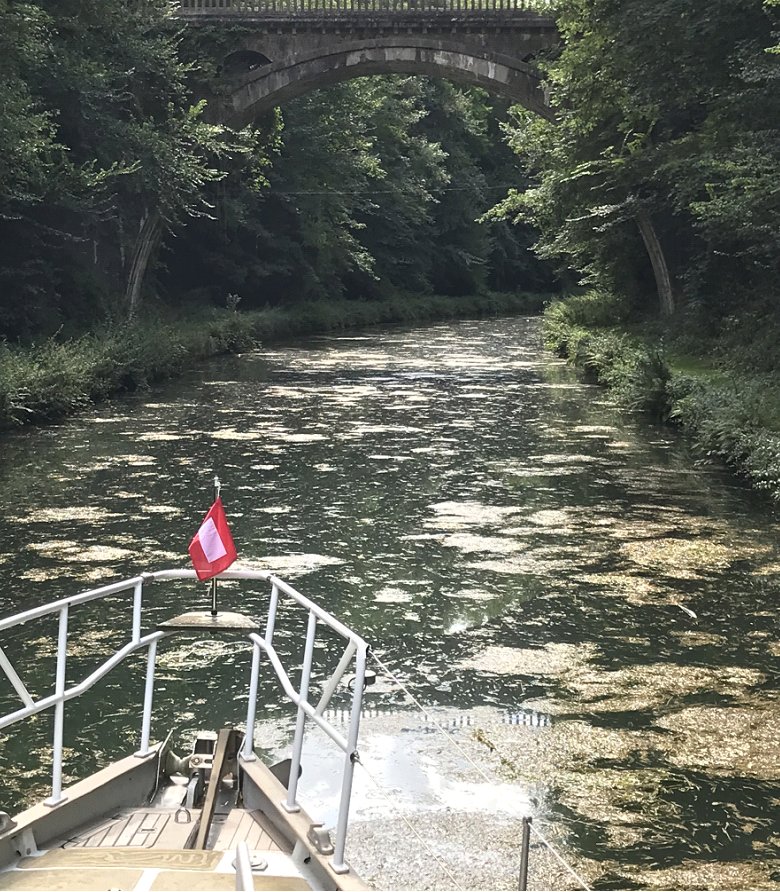 |
The downstream part of the Saint-Quentin canal becomes full of weeds, and we must check the raw water filter at any stop. |
At 16 we tie up at a finger pontoon in the port de plaisance of Saint-Quentin; the office is closed, but the owner of another boat gives us the access code for the gate to get out (and in). Other than the gate, the place looks completely deserted and there are no facilities.
August 8, Thursday: Saint-Quentin – Chauny [40 km, 13 locks, 6h]
We leave at 8:45 with some trubles in starting the engine: more than 10 seconds of starter running when it is cold. At 9 we call the itinérant of locks 22-25, and we pass them in the same way as yesterday. We stop at 15 at the halte nautique of Chauny, after having received the phone number of the itinérant for the last 2 locks for tomorrow. We realize that the ‘package’ Ecland + La Cane is now considered as a single unit by the VNF staff, and they know exactly where we are. Moreover, the simple fact that we fill up a lock at every passage makes them happy, as they don't waste water for a single boat, and this is their main concern in such a period of drought.
As we arrived early, we make a tour in the small but pleasant village.
We have set with Per e Mette a ‘cohabitation’ system that works fine: every evening we meet and have a look together at the charts, and decide in principle where to stop the following day and at what time to leave; under route La Cane is always at a short distance, and when approaching a lock they come even closer; when we slow down to examine a possible mooring, we are close enough to share our feelings in mime, even if we always agree. Sometimes we use the VHF, but only when really needed.
Relax in a bistrot downtown Chauny. | 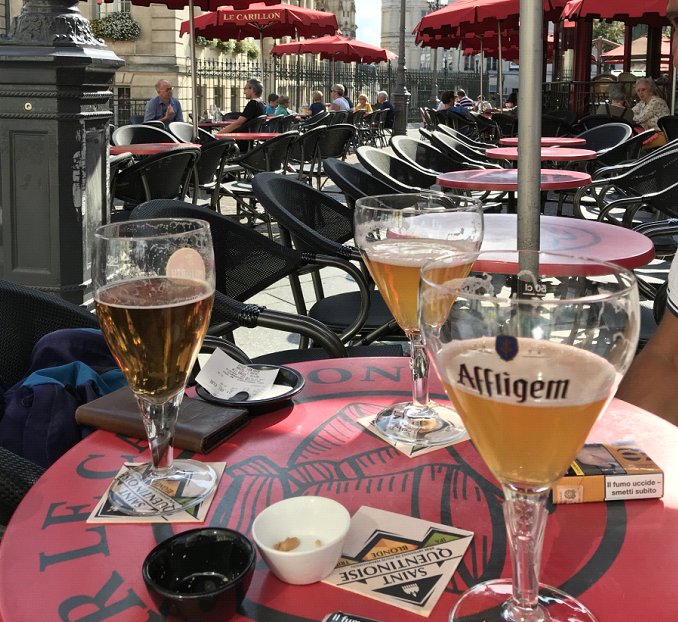 |
August 9, Friday: Chauny – Compiègne [41 km, 4 locks, 5h]
We leave at 10, and always assisted by the VNF itinérant we pass the last two locks in the Saint-Quentin canal that need a remote control, giving it back at the last lock.
At 14 we enter the river Oise, where locks are larger and always managed by a resident lock-keeper forewarned via VHF. Operators are always kind and tend to speak only French, but this is not a problem for us; other than the usual courtesies, they are just interested in two informations on our side: weather we are a pleasure bot (plaisancier) or a commercial barge (commerce), and weather we are going upstream (montant) or downstream (avalant); and their answer contain one simple information: wait or go ahead; no complications!
At 15 we moor alongside the left bank at Compiègne, directly on the river, on a depth shallow enough to make La Cane grounding on the mud at her first trial.
August 10, Saturday: Compiègne
We spend a day in Compiègne, as Peter is leaving tomorrow. We take advantage of this stop to fix once forever our electric connections, finding the negative on the engine batteries so loose that we take it out by hand. We check all other connections, and now the engine starts at a very first trial, and also the batteries charge is working better.
We make our provisiions and a tour around the town, visiting the cathedrals and the Château de Compiègne, a small Versailles that used to be a royal lodge for Louis XV, then distroyed during the French revolution and finally rebuilt by Napoleon becaming one of his country residences.
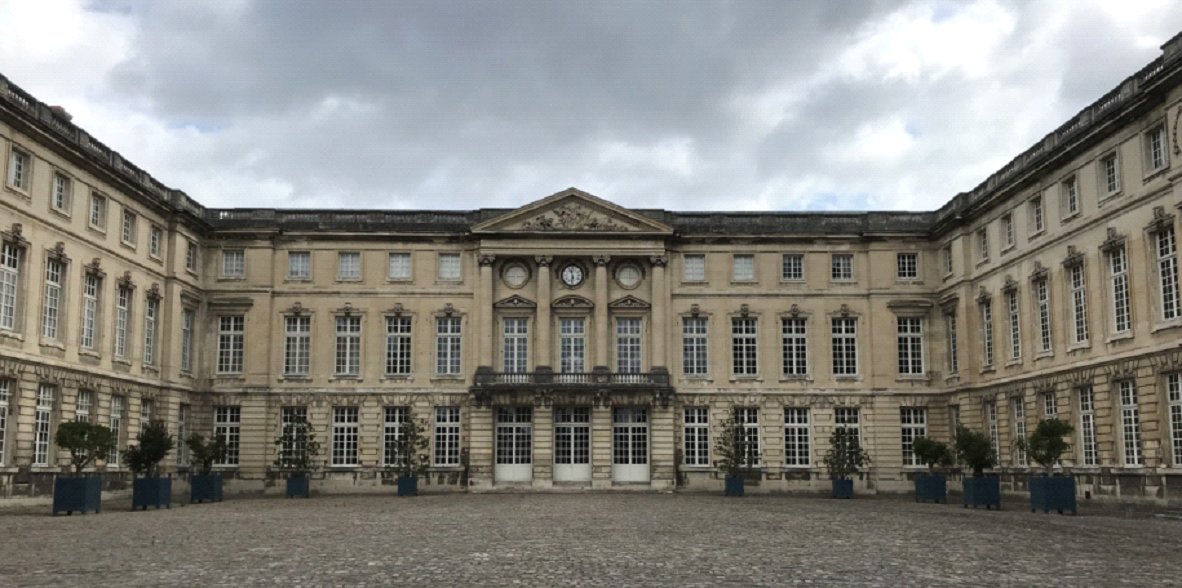 | |
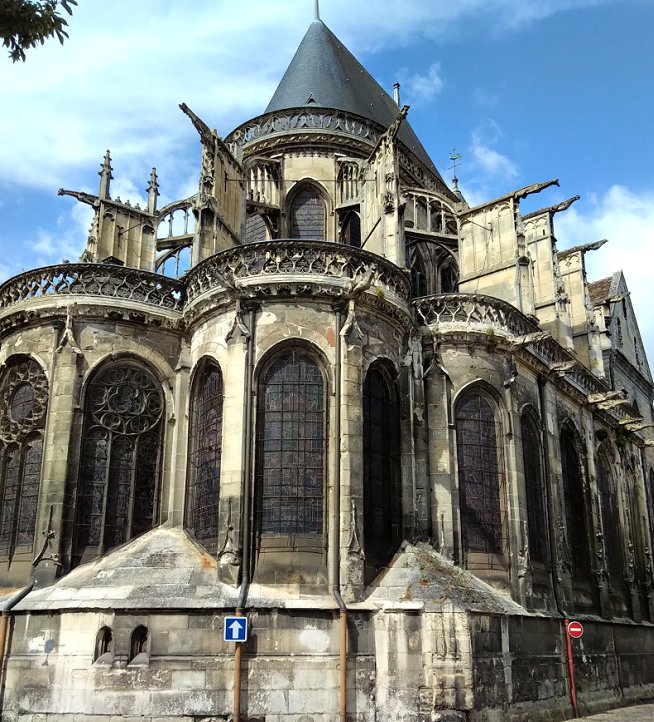 |
Above, the small Versailles of Compiègne. |
August 11, Sunday: Compiègne - Boran lock [55 km, 4 locks, 7h]
Peter leaves at 5 in the morning, and we start the engine at 9. Just after the Venette lock we see some white smoke coming from the exhaust, and we stop at soon on the waiting dock.
We can't believe it, but we have again raw water in the engine cranckcase! This is the same trouble we experienced in Riga two years ago, when we thought it was caused by an act of vandalism, as there's no connection between the raw water cooling system and the cranckcase on our Perkins. During the winter in Riga we took the engine out of the boat and had a complete revision made by a Perkins specialist: after a bench-test, everything was perfect. So we empty the cranckcase, change the filter and fill with new oil, without understanding how it could have happended again. One hour later we start again, with the engine running in the ordinary way, and with no smoke.
Our attempt to find a place in the Creil village is vain, and the same in other villages further south, so we go on. At 16:40 we tie on the waiting dock upstream the Boran lock, out of the traffic, with the authorisation of the lock-keeper. The spot is wonderful, nothing around except the lock, on a small island in the middle of the river Oise, and with no other noise than the sound of the water flowing across the dam on the other side of the island.
August 12, Monday: Boran lock – Pontoise [27 km, 2 locks, 3h]
After what happened yesterday, before leaving we check the oil level and ... we find water again. We take out 3 litres of water and half a liter of oil, without touching the filter, as the engine hasn't turned yet, so the water that came in during the night did not circulate in the system: we just add some fresh oil. At this point we decide to shut the raw water entrance of the cooling system at any stop, as this remains the only possible water inlet, even if none of us can explain how this water can get into the cranckcase. We leave at 9 anyway and at 12 we moor at the halte nautique of Pontoise, the last town before the intersection wih the river Seine.
As decided, we close the seacock of the engine cooling system, and we'll see tomorrow morning. We also tighten the connections of the service batteries, that began giving the same troubles of the engine batteries a few days ago, and to be sure about our engine conditions after the water intake, we check and purge all four injectors and the fueling circuit. Together with some provisions, we buy 8 liters of engine oil in a service station, as our stock is quickly running short.
August 13, Tuesday: Pontoise - Île Saint-Denis [57 km, 2 locks, 6h]
First thing to do, open the seacock and check the oil level, which is fine: maybe we've found where the water comes from? Maybe, but we cannot understand how it goes in the wrong place! Anyway, never lack spirit! The engine starter works fine too. We leave at 8:30, pass through the Pontoise lock, and at 10 we enter the river Seine at Pk 71, with much less traffic than expected.
As we are ahead of our schedule and nobody is running behind, at 14:30 we stop alongside a barge-bar closed for holidays, at Pk 28 of the river Seine, in the left arm of Île Saint-Denis, out from the river traffic; La Cane comes alongside us. We call Marco and Rossella and port de l’Arsenal in Paris to confirm our arrival tomorrow morning: we just have to call l’Arsenal on VHF channel 9 when ready to pass through the lock.
August 14, Wednesday: Île Saint-Denis – Paris [28 km, 2 locks, 4h]
We leave at 9, after a look at the oil level, which is still fine, and at 12:30, after an unforgettable crossing of Paris, passing aside of the Louvre, under the Pont Neuf and behind the abse of Notre-Dame under work after the fire of april 2019, we get in front of the small lock that divides the bassin de l’Arsenal and the river Seine. To me, that never used a bateau-mouche in Paris, the city seen from the river looks completely different: non only the historic Paris, also the buildings of la Défense, seen from the water, gain a different appeal. The entrance in Paris by the river is one of the unforgettable highlight in our sailing experience, as were the entrance in New York in 2000 and the entrance in Saint Petersburg in 2017; we must thank the drought of this season for having being able to make it. Marco and Rossella have followed us biking along the berges while Ecland and La Cane were crossing Paris, making an exceptional photo-reportage! The day after tomorrow they will board for a day's trip.
At 13 we are inside the bassin de l’Arsenal, where Marco preceded us to help with the ropes, and he also gives us the Marne and Champagne-Bourgogne guides that I asked him. We are exactly downtown, 200 metres away from the Bastille. In the evening we all have dinner together in an Egyptian restaurant. Giorgia will reach us tomorrow at around 13.
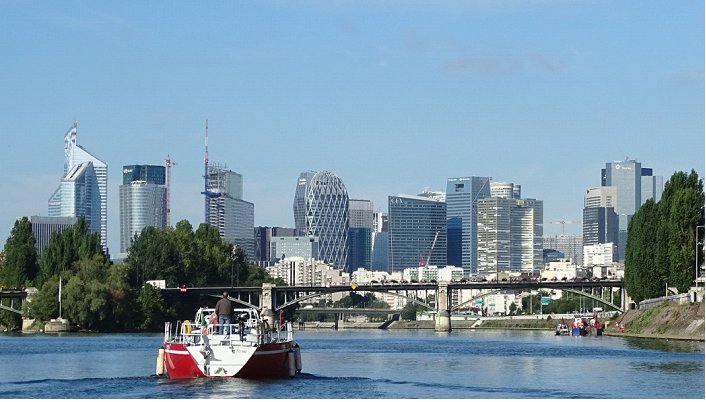 |
Passing by la Défense ... |
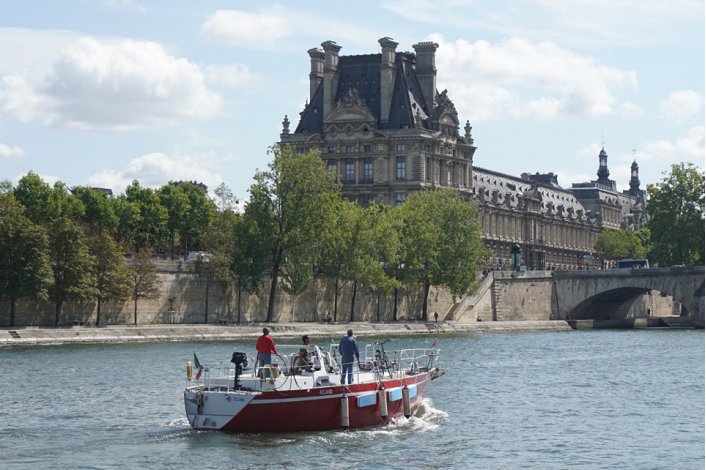 |
... the Louvre ... |
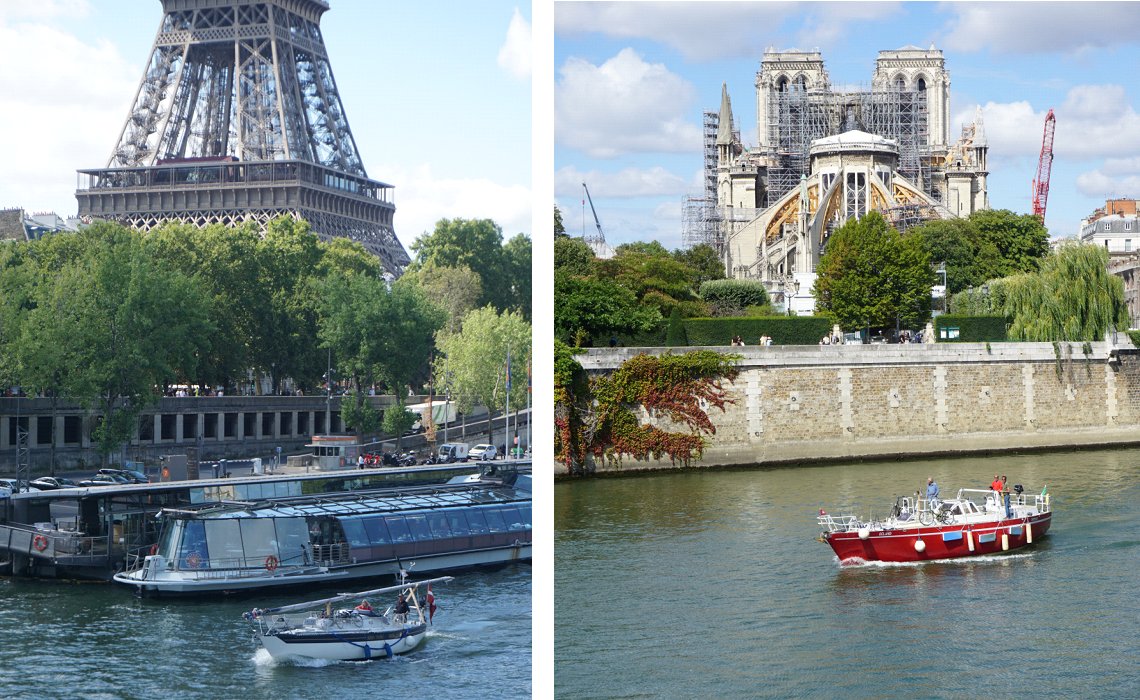 | |
... La Cane under the Tour Eiffel ... |
... Ecland behind Notre Dame... |
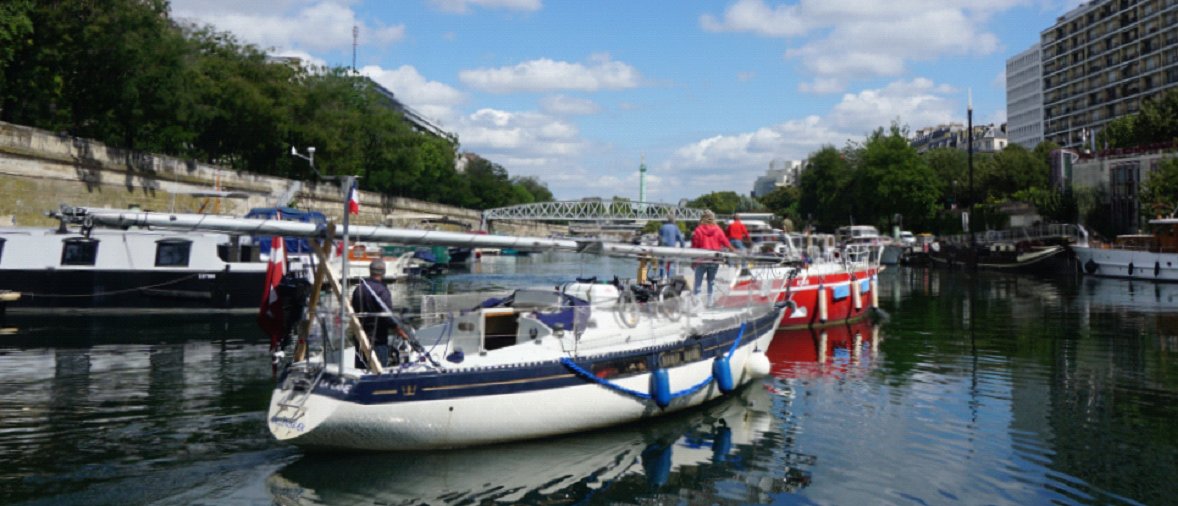 |
... and both in the bassin de l’Arsenal: on the background the column in place de la Bastille. |
August 15, Thursday: Paris
We stay in Paris, where Per and Mette have never been. We all know Paris quite well, so we just relax: provisions, water, oil check (we never know...); we are also allowed by the marina staff to dispose our cans full of a mixture of oil and water, gathered in the past days, into a waste oil tank. We hang around the Bastille and the Marais district. Giorgia joins us at 14.
We also look for some long stakes to be used for mooring on the canals, as we read that along the Champagne-Bourgogne canal we may often find no bollards or other holds available at the haltes nautiques, and it's forbidden to tie to the trees, because of the small road running between the bank and the wood, where VNF vans run at full speed. Without finding them, we buy a length of zinc gas pipe and have it cut into 40 cm long stakes by a local blacksmith.
August 16, Friday: Paris - Isles lock [72 km, 9 locks, 1 tunnel, 9h]
At 8 we are ready and at 8:15 we are out of the Arsenal lock, together with Marco and Rossella who are going to stay with us for the day. At 10, passed the Saint-Maur lock and tunnel, we enter the river Marne, heading east.
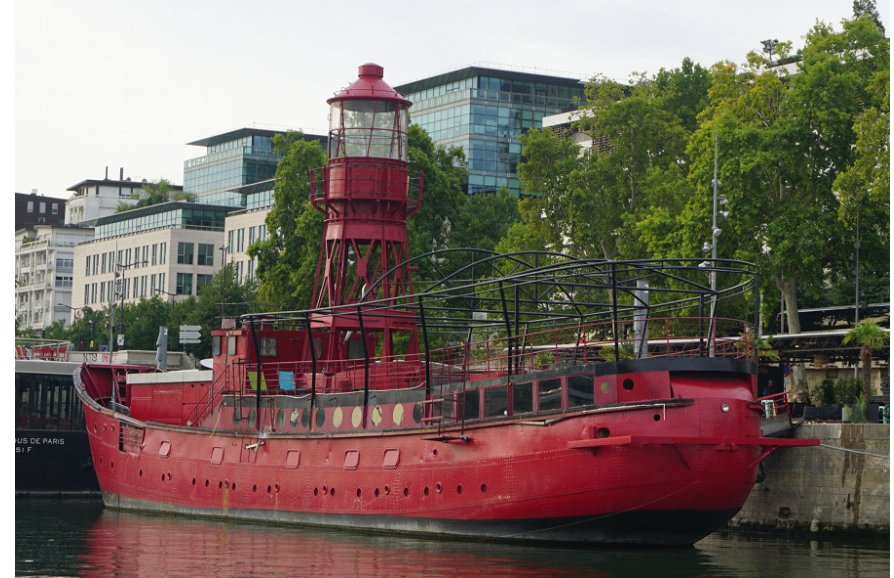 |
The old ligh-ship moored at the east of Paris, before the intersection between the river Seine and the Marne. |
Locks in the river Marne are much larger than the Freycinet gauge, with an impressive flow through the sluices: Franco, manoeuvring at the bow, has to work hard on the rope to keep the boat steady!
Haul, Franco, haul! | 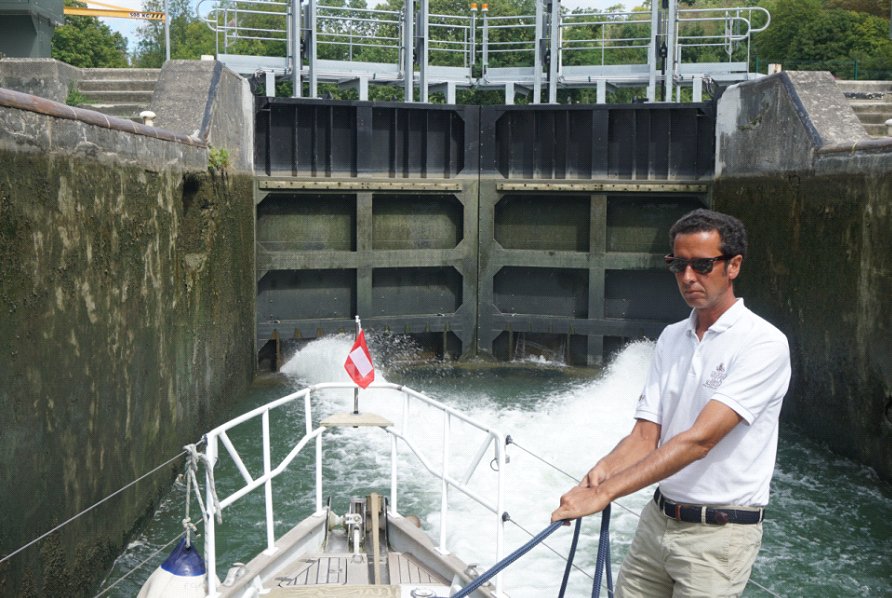 |
We are crossing an area of dense population along the Marne, with a variety of small little villages, both residential and holiday resort, full of people fishing from the banks, swans swimming undisturbed, and grey herons watching our passage.
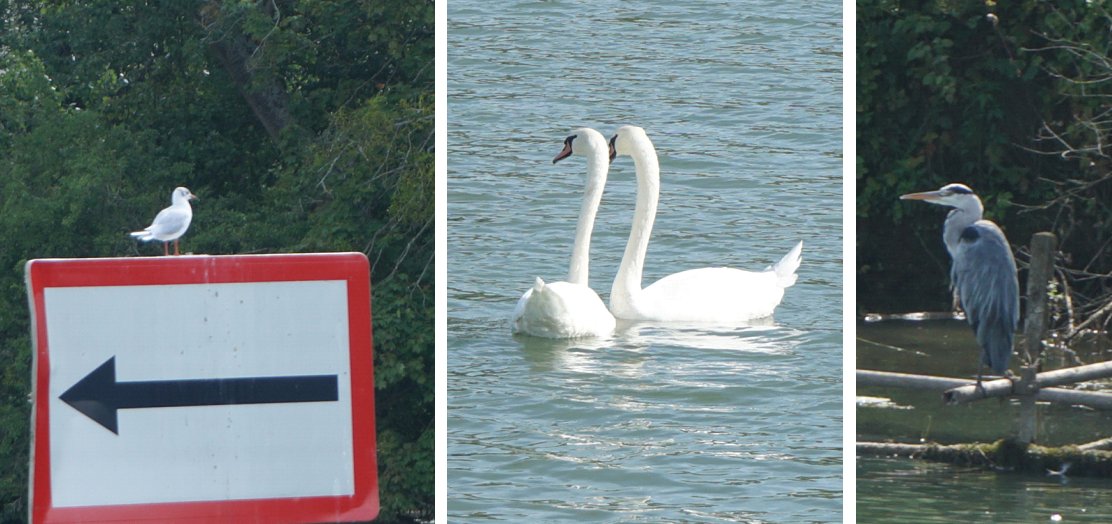
Avian fauna of the river Marne.
Further east, along the lateral canal that hugs the river when its draught does not allow for navigation any more, the landscape returns bucolic.
 |
The bucolic landscape of the Marne lateral canal. |
The day is shining and navigation is pleasant and relaxed: Rossella runs around to complete her photo-reportage.
At 15, inside the basin of the Meaux lock, Marco and Rossella get off and, after untying our moorings, catch a train to Paris.
Marco and Rossella let our moorings go in the Meaux lock and go back home to Paris by train. | 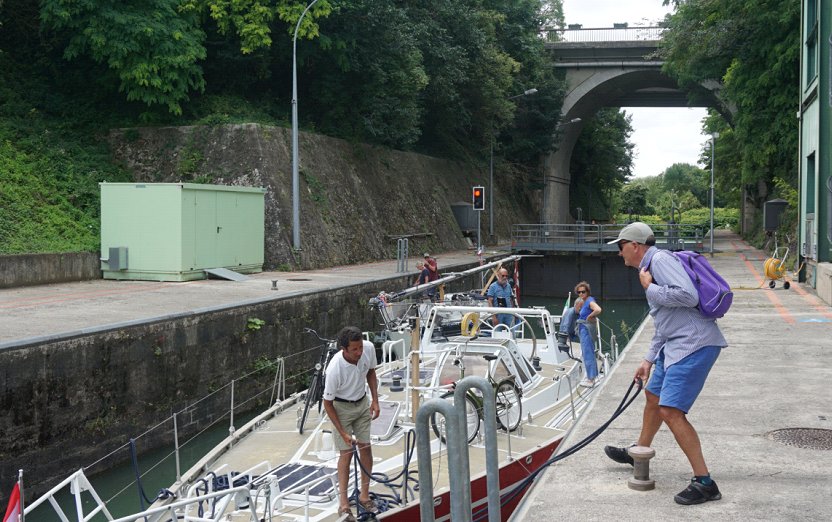 |
We moor at 17:20 just after the lock of Isles-les-Meldeuses, with a couple of stakes into the grass. Once again, peace and silence are absolute.
August 17, Saturday: Isles lock - Château-Thierry [64 km, 5 locks, 7h]
We leave at 9 with a flabby weather. At the lock of Saint-Jean we get the remote control for the next automatic locks: the operator tells us that we can use one single remote if we get close enough, but we prefer having one each, as we don't want to experience the same troubles we had in the Saint-Quentin canal.
Before some of the locks in the larger French canals there is often a waiting spot for barges, made by a pair of blue steel dolphins standing out of the bank, with a landing gangway, but they are outsize for us: sometimes we use them while waiting for a lock to open, but we would never dare to stay overnight.
At 16 we tie up on the right bank after the bridge of Château-Thierry: we are a bit far from town, but the pontoon of the halte nautique downtown was full. Weeds are thicker than ever: from now on we have to check systematically our raw water filter.
August 18, Sunday: Château-Thierry - Château-Thierry [2 km, 2h of which 1h30 towed by La Cane]
We leave at 9. Half an hour later, we see a lot of smoke and no water coming out of the exhaust! With a quick look into the engine room, I see that the impeller of the raw water pump doesn't turn. We shut the engine and throw a line to La Cane that tows us back to the dock we left half an hour before.
I let the engine cool down for a while, an then get into the engine room and take the pump apart: the engagement between the pump and the camshaft is totally destroyed: on the pump side there is the female part of the coupling, that instead of having a strait slot 4 mm large and 2 cm long, has a shapeless mass of material craked on both edges; on the camshaft side there should be the male part of the coupling, where the corresponding spline has been reduced from 2 cm to a few millimetres. No wonder that the pump doesn't turn any more.
It's a real disaster. Today it's Sunday and we cannot do anything; it's also raining now. I can just look for the part numbers of both sides of the coupling in the workshop manual that I carry on board, and see if they are still available somewhere. Our engine is an old Perkins Prima M60 that is not produced any longer, but I know an online dealer in the UK, called parts4engines.com, that keeps in stock some spare parts of old Perkins. Internet connection is fine, and I surf their website to check: the engagement on the pump side is not available, but the entire pump and the camshaft engagement are. It's better than nothing.
By now I cannot do more, we will see tomorrow. My mood is really bad. Per tells me that La Cane will wait for us all the time we need: he's a true friend.
 |
The engagement between the raw water pump and the camshaft of our Perkins. Left, how it should be, and right, how it was. Little chance to have the pump turning! |
August 19, Monday: Château-Thierry
I wake up early and as a first task I look for a workshop nearby to verify weather it's possible to have the spares from a French dealer in a reasonable time. After a long research I get to the Fevrier workshop; the staff is very kind, and with the part numbers at hand they call a dealer in Liège, who half an hour later answers that it's possible to have the parts shipped from the UK in 3-4 days. This is most probably my same dealer, so I give up with them and ask weather I can use their address to receive a parcel from a courier; their answer is positive.
Back on board, I call on the phone parts4engines.com to check if the spares are really in stock, and their answer is once more positive. I ask them how much time they think the parcel will take to get to Château-Thierry, and their answer is that, if I place the order before midday and choose a delivery with UPS express, I may receive the parcel by Tuesday morning. The Internet connection is still good and it's 10:30: I place the order, enter Fevrier's address and my credit card number, choose UPS express and press Enter. The whole history will cost me 380 pounds.
Now there's nothing else to do than wait. It doesn't rain any more, and we make a tour to the fortress of Château-Thierry, one of the more ancient medieval castles in the region, that in other circumstances could have been really nice. Today, by the way, it's my birthday, and we drown the evening in a generous dose of gin and tonic and in some red wine the crew bought for the occasion, together with our friends of La Cane, with some improvement in my mood. I've downloaded the UPS app on my smartphone to track the parcel, and before going to sleep I know that it's in transit towards France. Let's hope for the best.
August 20, Tuesday: Château-Thierry - Port-à-Binson [35 km, 3 locks, 7h]
I spend the night with nightmares populated by cracking gears and leaking pumps; I'm up at 8 and the UPS app tells me that the parcel is already in Liège, some 100 kilometers from here. I begin walking nervously up and down the bank; my crew looks at me with an apprehensive glance, probaby Per and Mette are worried too.
At 10 o'clock, one of Fevrier's employees bikes towards the bank, shouting that there's a parcel for me at the workshop. I begin feeling better: the parts are exactly what we need. I plunge in the engine room, trying to reassemble the system quickly and without making mistakes: at midday everything is fixed and after a trial we leave.
20 minutes later, we feel a fall in the engine regime; we bleed some air from the fuel filter, but I prefer going back to the dock for a more careful check. In fact, moving around the engine room I raised the fuel pipe and let some air into the system; now everythig looks fine.
We try again, but nothing good: no water from the exhaust, and we go back to the dock. Per and Mette are always with us... I check pump and filter, but this time I simply forgot to open the cooling water seacock before leaving!
At 13:30 we leave again for the third trial, and this is the righ one: everything is working. Constantly checking what's getting out from the exhaust, we reach our normal pace; three locks later, it seems to us that the problem is definitely fixed. Thanks to parts4engines.com, thanks to monsieur Fevrier, thanks to UPS and thanks to the whole crew, including Per and Mette, for their patience!
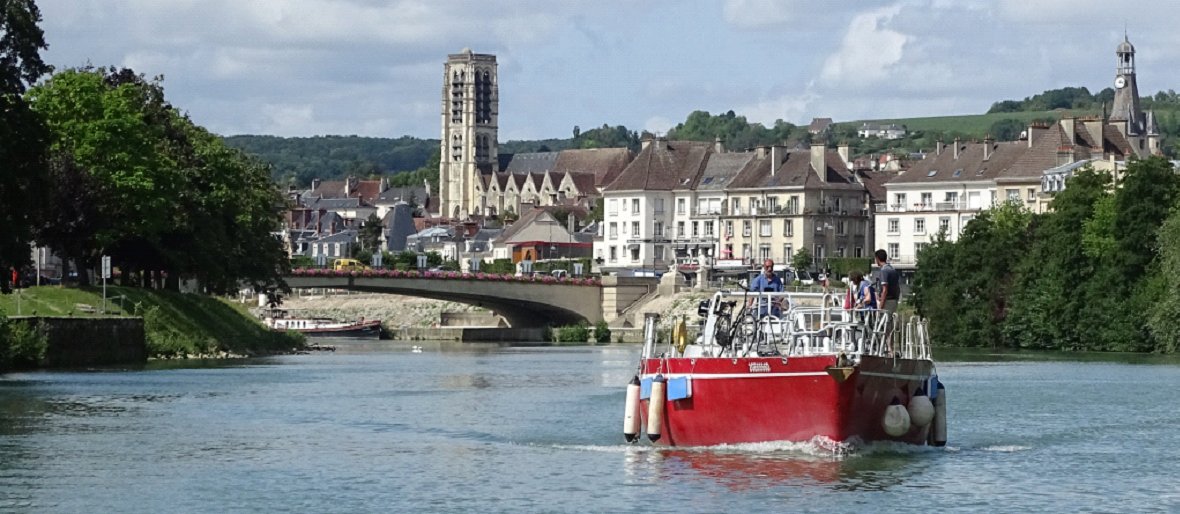
Leaving Château-Thierry for the third (and last) trial.
Far left, the dock where we've been moored during the last three days.
At 17:45 we tie up to the halte nautique of Port-à-Binson (Pk 15), a small spot not even shown on the charts, just before the village of Reuil. The pontoon, placed in a side arm of the river Marne and sheltered by a small island, looks brand new: it's absolutely deserted, next to a camping area deserted as well, and with an incredible draught of 3 metres. There is also a water plug fitted for our pipes. Here again, swans come to visit us when we prepare our aperitif, which I enjoy with no more stress.
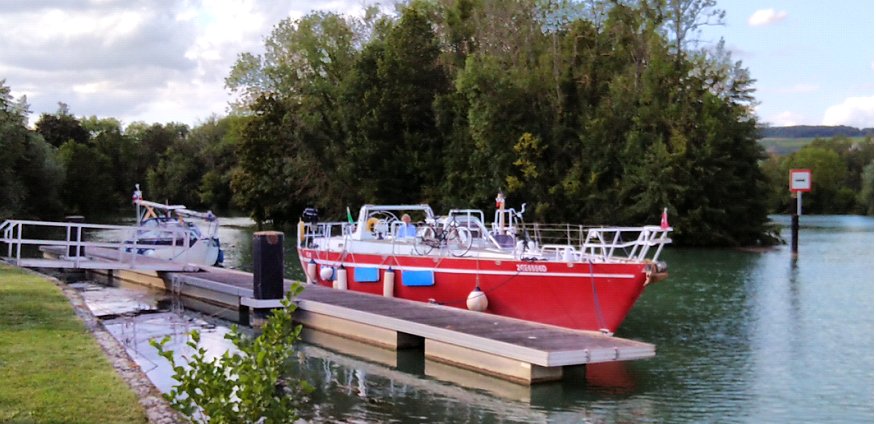 |
The halte nautique of Port-à-Binson. |
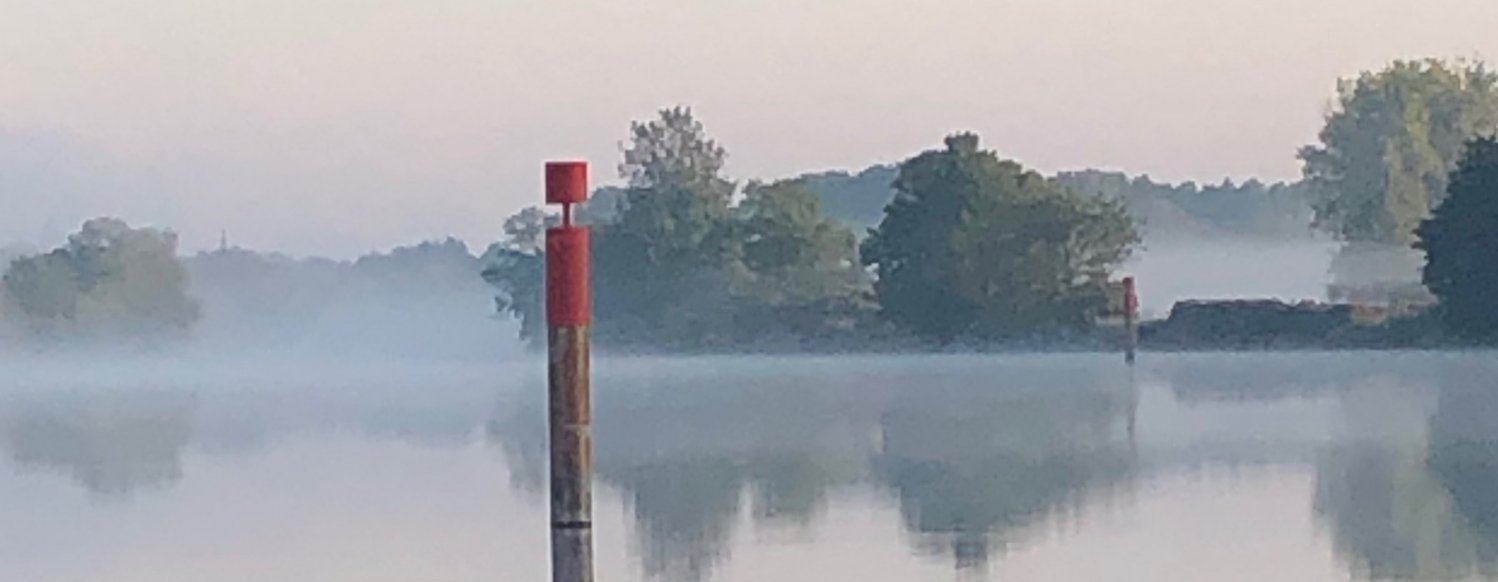
The river Marne early in the morning, with a layer of evaporation fog on the water.
August 21, Wednesday: Port-à-Binson - Châlons-en-Champagne [50 km, 9 locks, 1 bridge, 9h]
Departure at 8, wih some evaporation fog lying on the water, making the lanscape picturesque. The first lock is off and doesn't react to our remote. We call the VNF headquarter of the north-east region, that sends an operator very quickly; it's the first time we see a lock with a floating pontoon inside the basin, due to the presence of sloping walls. At 9 we are out.
From the second to the third lock we proceed slowly behind a tourists' péniche, but the weather is beautiful and our mood is high again. Before the fourth lock, the péniche stops on the bank and we can speed up again.
The tourists' péniche, behind which we had to slow down, stops for lunch and lets us go ahead. | 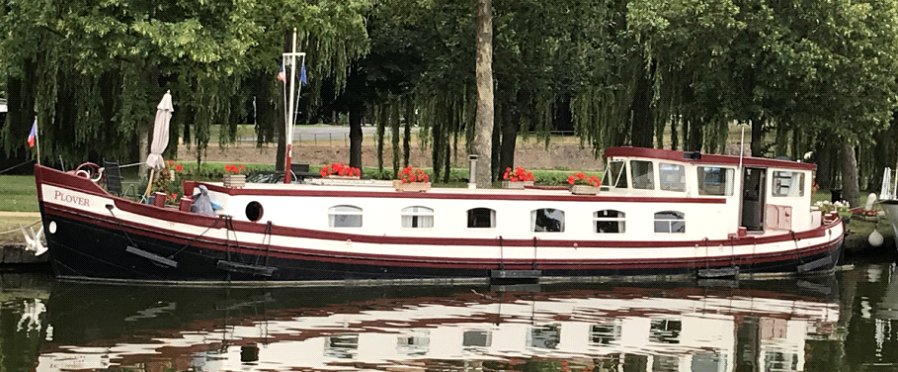 |
At 17 we moor in the port de plaisance of Châlons-en-Champagne, a nice place but very crowded, and we have to tie up to the wall right at the entrance of the basin, not quite the best. On the other hand, the place is wonderful, and the services of the relais nautique are 5 stars. We make a tour downtown to see the gothic cathedral and fill up our stock of gin and tonic water.
In the evening we try to fix a problem with our gear wire that gave us some engaging troubles today, but we discover that the fault is just of the inside lever, that we did't leave exactly in the idle position after our engine trials in Château-Thierry.

Unconventional mooring at the entrance of the harbour in Châlons-en-Champagne, and its relais nautique.
August 22, Thursday: Châlons-en-Champagne - Orconte [47 km, 14 locks, 8h30]
After the usual check of oil and weed in the water filter, we leave at 8:30; we have also pasted a nice card next to the start button that remind us to open the water seacock.
At 13 we pass near the town of Vitry-le-François, where we leave the lateral canal of the Marne to get into the canal between Champagne and Bourgogne. At lock n.71 of Désert we give back our old remote control and take a new one, that will work throughout the canal. All locks from now on are of Freycinet gauge and very close one to the other. The canal itself is narrow, with just room for two boats crossing and going very close to the banks. The forecast is correct by now and we find 1,7 metres of water in the middle of the canal: we hope it will last down to the end.
Around us, beyond the small woods lining the canal, the Champagne's vineyards are leaving place to the Burgundy's vineyards. We tie up to the halte nautique of Orconte at 16:30, just after lock 66: a simple quay 30 metres long in the middle of the wood and a small hut with water and services; we don't seek for more.
August 23, Friday: Orconte - Autigny lock [44 km, 19 locks, 8 bridges, 10h]
Departure at 8:30, ahead of a commercial barge that kindly lets us go; in this way we discover that our remote control, made for pleasure crafts only, works even before 9, despite what the staff told us. We try to go as far as possible, locks permitting, but we now are used to their 5 metres width and we work out in getting into the locks at a decent speed without touching somewhere.
Passing through one of the several lifting bridge, La Cane lags too much behind us and the bridge begins to close when the boat is just taking the passage! Per succeeds in stopping at full speed astern, hopefully La Cane is quite light; he has to go back for a length and relaunch the system with his remote. We wait for him in the middle of the canal and then start again. In this section there is an incredible number of lifting bridges, with a narrow passage, the same size of the locks!
A few miles ahead, out of the village of Saint-Dizier, the bridge doesn't want to respond to our remote: it remains blocked on red and green, without switching to green and opening: we have to call the VNF itinérant, that should be nearby as at the other side of the village we passed a lock with somebody in the control house; but now it's lunch time, and we have to wait. At last, with a light wind moving us too close to the bridge, the operator comes and opens.
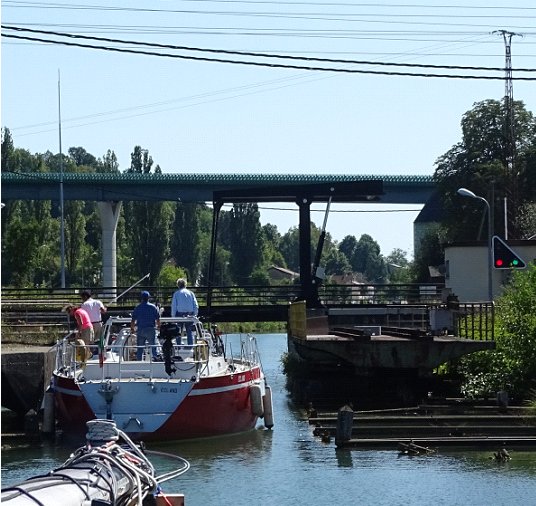 |
Waiting for the VNF itinérant to finish his lunch and come to open the Saint-Dizier bridge blocked on red and green. |
Slow, very slow, and a good eye for the width! | 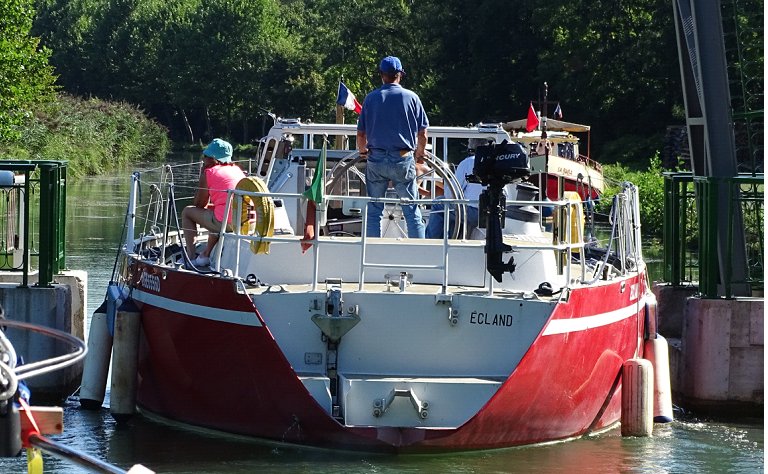 |
Getting out of lock 53, we find a péniche waiting for her turn, stopped exactly in the middle of the canal, with very little room between her side and the bank, and with no intention to move. We manage to pass with Ecland at a walking pace 10 cm from her side and from the grass, over 1,5 metres of water, but when it's the turn of La Cane the péniche begins moving, and Per hits his keel against something much harder than mud! He eventually comes out, almost pulling himself along the péniche side, but as he doesn't look worried we start again.
At 18:30, after 19 locks and 8 lifting bridges, we have had enough and tie up to the left banck of the canal just after the Autigny lock (n.47), with nothing but a few cottages around.
The short quay is fit for one single boat and has something less than 1,5 metres of water, so La Cane comes alongside and we stand out a bit too much towards the middle of the canal, but half an hour later the locks lights go out and there's no more problems.
What we've done today is the maximum distance we can cover in one day in this canal, and we all are a little tired. Giorgia got accustomed very quickly to the cruise pace. We have a meeting and review the plans in order to be in Langres on the 26th (Monday) during opening hours of shops and VNF office, because just after Langres the canal reaches its top and the passage through the corresponding tunnel has to be booked in advance: nevertheless, we can allow ourselves not to make very long hauls any more.
August 24, Saturday: Autigny lock - Vouécourt [32 km, 12 locks, 2 bridges, 7h]
We start at 8. The weather is fine, quite hot, but the canal is sometimes lined by tall lines of trees that give some shadow, and the breeze generated by our speed is enough.
Along the banks we often meet a lot of fishermen, sitting under the trees with their lines thrown far away in look for their fish, far enough for us to be obliged to move from the center of the canal: a wave and we go on.
Beyond the trees we are circled by the Burgundy's vineyards, lying on the gentle slope of the hill.
We stop at 15 at the halte nautique of Vouécourt (Pk 89), before the lock with the same name, after ‘only’ 12 locks and 2 bridges. There is nothing but a few houses, a post office and a small church, but the place is quiet and the camping site on the opposite bank offers some facilities; tomorrow however we intend to stop in Chaumont, a bigger town.

Burgundy's vineyards.
August 25, Sunday: Vouécourt - Foulain [35 km, 18 locks, 4 bridges, 9h of which 1h stopped]
On Sundays locks begin working at 9 for everybody, and we are on time. Around 12, while passing through the lock of Condes, the operator warns us to slow down because further ahead there is a barge stuck in the middle of the canal, and indeed we find her one hour later.
We stay there from 13 to 14, almost leaning against the left bank, waiting for the barge Rogi, with engine troubles, overloaded, and stuck in the mud, to get out and move again; we are not alone in the waiting list, in both directions.
One hour later Rogi gets her keel out of the mud and lets us go ahead, in a widening of the canal in connection with the wharf of a silo. At the next lock, the same lock-keeper however advises us not to stop in Chaumont, not far from here, and to make as much route as we can, because if we stop and the barge goes ahead, there will be no places to overtake her again, and the barge runs at the miserable speed of 4 kilometres per hour.
Waiting for the Rogi to get off from the middle of the canal. | 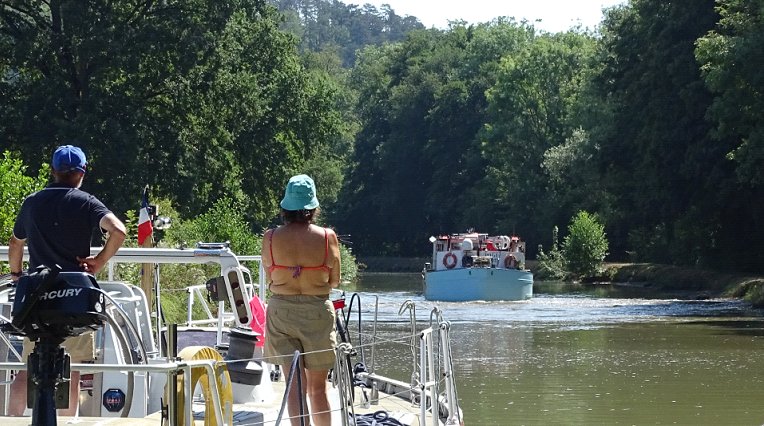 |
So we decide to skip our stop in Chaumont and we go further south, down to the halte nautique of Foulain (Pk 123), placed in a large bend of the canal, where we arrive at 18. There are only two pontoons already busy; hopefully one of them is taken by a Dutch péniche some 30 metres long, and the owner kindly invites us alongside. La Cane, after a trial in a smaller place with not enough water for them, comes with us and we can easily tie all together to the péniche, one in front of the other. After a check to our fenders, the Dutch boatman disappears downstairs and we don't see him again.
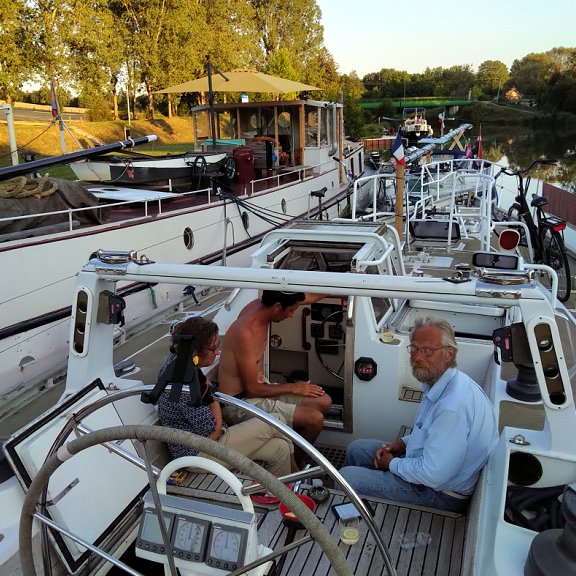 |
Large péniches are a godsend, if the owner is friendly! Here in Foulain we have both room alongside. |
August 26, lunedì: Foulain – Langres [24,5 km, 14 locks, 1 bridge, 6h]
Departure at 8. Locks are almost all empty already (as we are going upstream, this means that we can directly get in) and we run much quicker than usual.
At 14 we moor at the halte fluviale of Langres, with just the depth to float. We arrange a meeting to cross the Balesmes tunnel for tomorrow morning at 10, and then jump on our bikes and ride in town for complete provisioning: along the downstream section of the Champagne-Bourgogne canal there are almost no resources nor haltes nautiques, and we have to be self-sufficient and to think up something for our stops. Langres is on the top of a hill, and we have to push our bikes up the steep climb, and also check our breaks before coming down! Per and Mette don't trust theirs and prefer to push their bikes even downhill.
Alas, while we are enjoying our aperitif in the evening, the barge Rogi passes by without stopping: they ricognize us and tell not to worry, as they will be passing through the tunnel tomorrow morning at 7. We hope not to catch them up during our route down to the river Saône.
We make our usual checks on oil, weeds, and fuel: we have more than 100 litres left in our tank, so we can get to our final destination without problems. We also make good use of the facilities in the halte nautique, as we won't find many before getting to Maxilly, at the end of the canal.
August 27, Tuesday: Langres – Piépape [21 km, 13 locks, 7h30]
We leave at 8 to be on time for the rendez-vous with the tunnel. Unfortunately lock n.1 of Batailles is down. We call the VNF, but there is some wind and I cannot stay still in the middle of the canal, so I tie up in some way almost under the bridge just before the entry gate of the lock.
One hour later the VHF itinérant comes and we pass through. At 11 we arrive at the entrance of the Balesmes tunnel and 15 minutes later we cross. VNF requires a long span of time between to boats inside the tunnel, so once we are out, we tie up alonside an uninhabited barge and wait for La Cane, that arrives at 12:30.
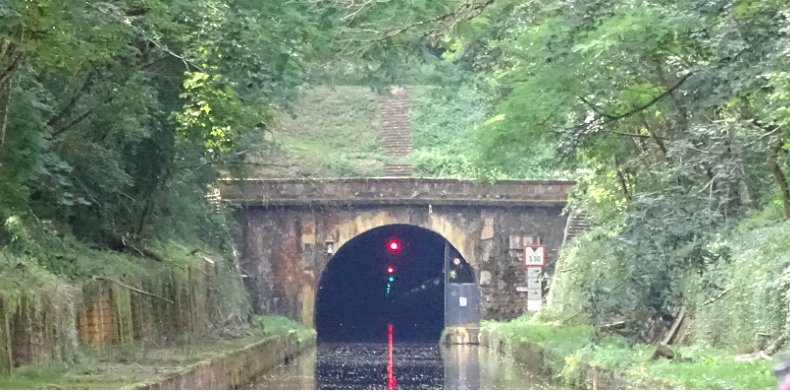 |
At the entrance of the Balesmes tunnel. |
We start before they stop; in this downstream section of the canal depths are considerably shallow: Ecland's keel, even without dragging, often grazes the weeds growing from the bottom with its sides, like in a giant vegetable car wash at keel size; La Cane, on the other side, whose draught is slightly more, often drags with its keel on the muddy bottom: we notice it by her speed and the growing distance between us. On the other hand, as we already saw before, downstream locks are much easier and quicker to pass.
Sometmes we cross the VNF itinérants without calling them: we see their white Renault van with the green and blue logo on the sides speeding on the path that borders the canal between the bank and the wood: they slow down, wave us (and in my opinion note our name and position) and then start again towards the next locks to check that everything is in order. They are a reassuring presence.
The van used by VNF itinérants to run from one lock to another. |  |
At 15:30 we tie up at the halte nautique of Piépape (Pk 169). We are both touching the ground, but not in a worrisome way. As we forgot to buy something in Langres, we follow the indications of our guide and of a home-made panel nailed to one of the trees nearby, declaring a boulangerie 500 meters ahead, and we come to am almost deserted small village with a few houses, a small church and a shop under renovation that may have been the foretold boulangerie. We don't care: at least, peace is complete.
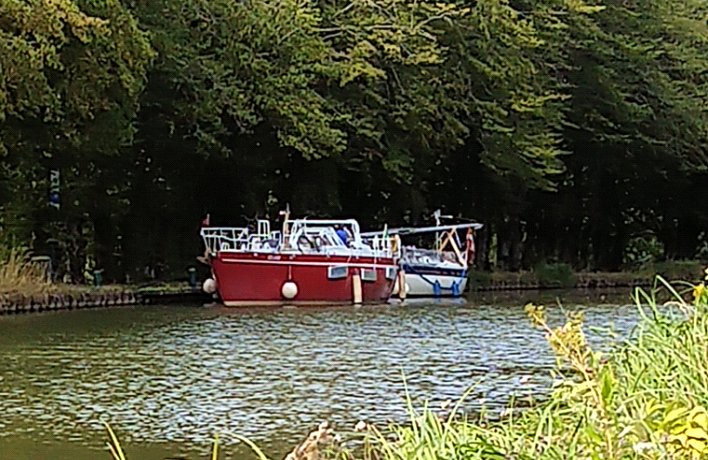 |
Piépape. |
August 28, Wednesday: Piépape - silo near Villeneuve-sur-Vingeanne [23 km, 16 locks, 6h]
We leave at 8:30. Along this portion of the canal there is really nothing: a few farms scattered in the middle of the wheatfield and nothing else.
Even if downstream locks are quicker than upstream ones, and manoeuvres are easier, we must take into account that the edge of the walls is often only 20 cm over the water surface, when the basin is full, and pay attention not to step over it with the boat, letting all fenders completely lying on the water; despite this, getting into a Freycinet basin has became a routine. These small locks tend to overflow when they are full of water, as the watertightness of the gates is never complete: this is the only sound we hear overnight when we moor next to a lock.
At times locks are so closed one to the other than you see the entrance of the next lock before getting out from the previous one. In such cases locks are grouped in chaines, and we just need to launch the operation of the first one: all other locks in the same chain automatically start their bassinage when the photocell of the previous lock detects that the boat is out. I don't know what happens when there is traffic both upstream and downstream, but in our situation, with nobody around, it works perfectly.
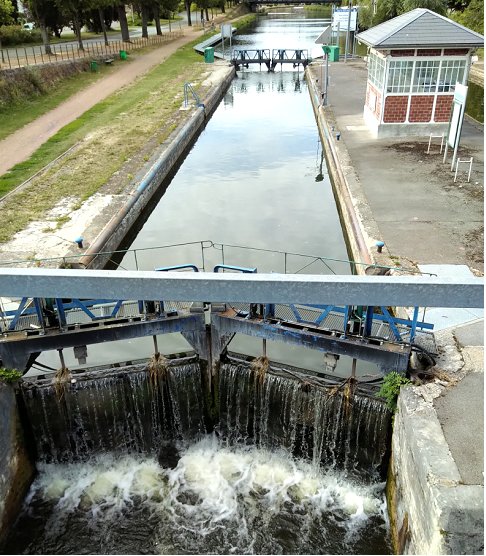 |
A typical Freycinet lock in the Champagne-Bourgogne canal, when it's full, with water overflowing from the top of the gate. |
The only place where we may stop today, following our guides, is an old deserted silo near the village of Villeneuve-sur-Vingeanne, at Pk 192. And here we moor (let's say) at 15, using a microscopic concrete pier 2 metres long and 1 meter wide, with all our fenders at midship and trying to keep Ecland balanced with three stakes on the bank; La Cane ties up directly to the bank, with other two stakes. Hopefully it's dead calm. Following the instructions we look for a restaurant in the small village of Montigny, but we find it closed for holidays.
Moored to (I'd say just leaning on) the small concrete spur in front of the deserted silo near Villeneuve-sur-Vingeanne: a few stakes on the bank, and a prayer for the wind to stay calm! |  |
August 29, Thursday: Villeneuve-sur-Vingeanne – Maxilly [30 km, 15 locks, 1 bridge, 9h]
We leave at 9. We have problems with locks 29 and 30, that do not respond to our remote control. As usual, we call the local VNF headquarter and after one hour the itinérant arrives to solve the problem. As we already felt before, we now understand that the VNF staff always knows who we are and where we are: it looks like the entity Ecland-La-Cane is for them the name of one single vessel 28 metres long! At the second lock, the operator is already there and we don't wait.
At lock 39, troubles again, but this time the problem is really unexpected: after the beginning of the operation, while we were approaching under the green and red lights, suddenly the lights switch to a double red (that means ‘lock definitely out of service’): something that you never want to see! We stop crosswise with our bow into the bank and call the VNF again. This time they are more reactive, with no questions about our name and position (they already know exactly who and where), and the itinérant arrives 20 minutes later. The electrical trouble seems unsolvable, so the poor guy takes out a big crank and makes our bassinage entirely by hand. What an effort!
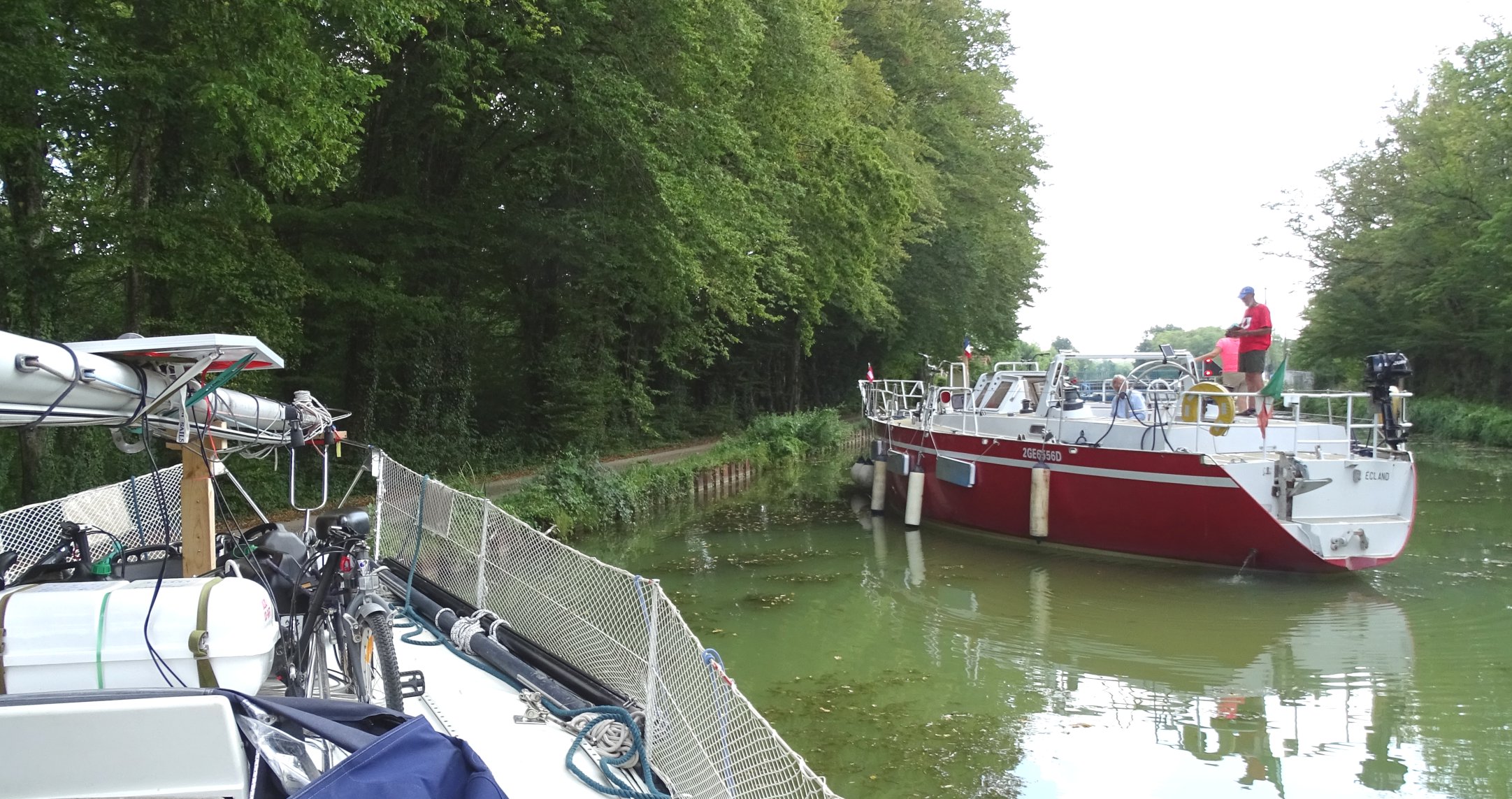 |
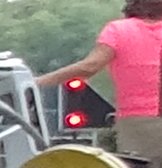 | |
Bow against the bank, waiting for the VNF itinérant at lock 39. | ||
At 18 we finally tie up to the halte nautique of Maxilly, our last stop before getting out of the Champagne-Bourgogne canal. At last a good shower!
August 30, Friday: Maxilly – Auxonne [22 km, 4 locks, 3h30]
We start at 10, give our remote controls back at the last lock of the Champagne-Bourgogne canal and get into the river Saône. From here to Auxonne locks are larger, all operated by a perch hanging down in the middle of the river at about 100 metres from the lock.
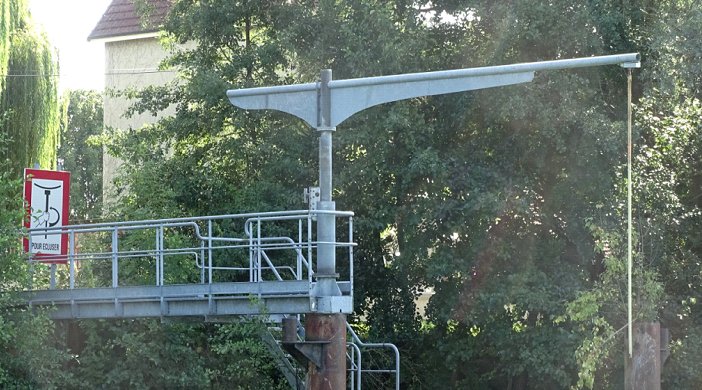 |
 |
The perch used to operate the
automatic locks on the river Saône, at about 100 metres on each side of
the lock, with a panel explaining how to use them. |
The landscape has completely changed and we begin going back to civilisation. We indentify from a distance the tall bell tower of the Auxonne cathedral and at 13:30 we tie up to the visitors' pontoon in the Port Royal of Auxonne, where John, the Australian harbour master of the H2O marina, welcomes us.
We begin working at the preparation of Ecland for the winter and book online our tickets for our trip home from Dijon on next Sunday.
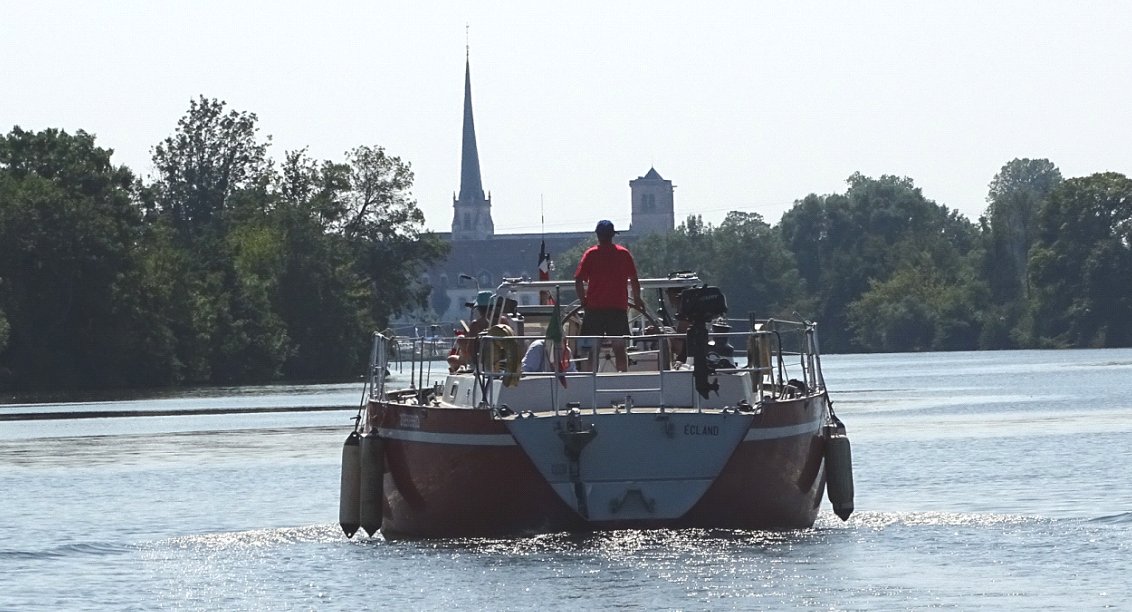
Our arrival in Auxonne. The cathedral bell tower is clearly visible from a distance.
August 31-September 1: Auxonne
We end up the Ecland's wintering preparation and move to her final spot, inside the first pontoon, setting ropes, fenders, papers, etc.
On the barge used as harbour master's office there is a webcam, and John gives me the coordinates to log in, move it and watch over Ecland: this will be one of my pastimes during the winter.
We have also some spare time to make a tour around the beautiful village surrounded by Napoleonic walls.
In the evening, our friends of La Cane invite us for dinner in a restaurant downtown; they will rest in Auxonne for a few days before leaving again towards the Mediterranean Sea.
Before leaving I lend Per the Cruising Association canals guide: he will send it back during the winter, full of useful notes on the second step of our voyage.
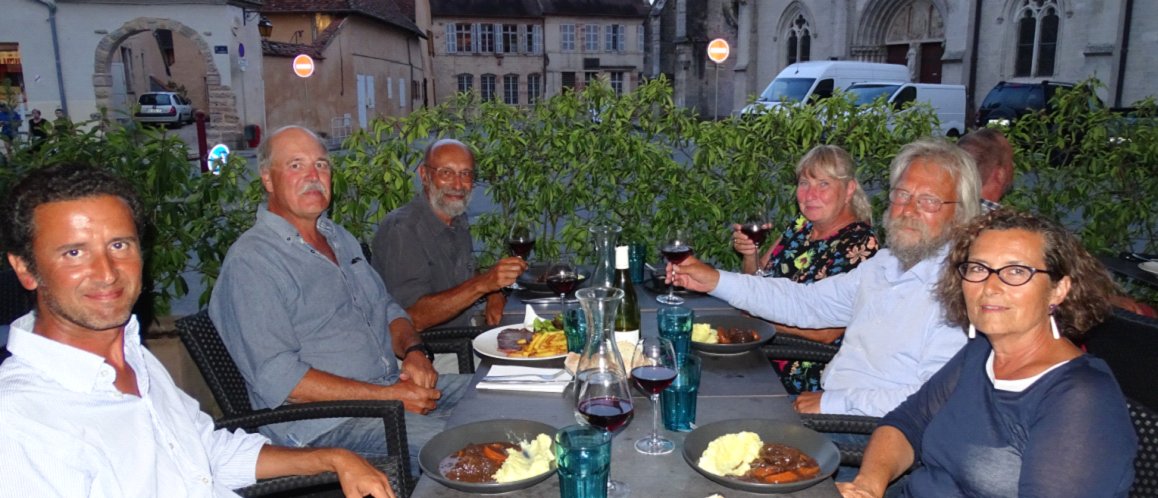
Our goodbay dinner at a restaurant in Auxonne.
The parting on Sunday morning is not easy: we started from Namur with a small Danish vessel following us, but after one month of ‘cohabitation’ we've ended in Auxonne with two real friends: we will stay in touch.
STEP TWO: 2020
During the first months of 2020, the first Covid wave gambles the second step of our European crossing. Only at the beginning of May, with the general improvement of the situation in Italy and France, I can get in touch again with Vassili in Auxonne, with the staff of Port Napoléon and with the VNF. Everybody tells me that the situation is fairly back to normality for cruising, with no problems under way, and with masks and social distancing when ashore.
This year we don't have to worry about drought: the rivers Saône and Rhone are not affected in an appreciable way. We plan to start at the beginning of August and reach around the 20th Port Napoléon, where our mast is waiting since last year, and then remast and leave Ecland afloat. Franco has to be back by August 25, and I don't think this will be a problem.
Actually our journey is much shorter than last year, less than 600 km and some 20 locks, but I don't know how navigation along the Rhone is going to be: commercial traffic, giant locks (11 to 23 metres of fall) and a south-going stream that may exceed 3 knots with possible troubles in manoeuvring, all this is uncertain.
Moreover it will probably be a crew of three: André, Franco and myself; Margherita, who could join us in Lyon, gave no certitude by now; in conclusion, even if it took 10 days last year to our friends of La Cane to make the Auxonne-Mediterranean length, I prefer to take some margin: we'll be on our holidays and seeking for some relax.
Speaking of La Cane: Per and Mette arrived in Port Napoléon and went on sailing after remasting, but in February, cruising northwards along the west coast of Europe to go back home, they stopped in Lisbon at the beginning of lockdown, and stayed there for two and a half months; they eventually succeeded to sail up to La Coruña, in Spain, leaving La Cane on a dry storage in Laguna Seca marina, and flying back to Denmark.
August 1-2, 2020: Auxonne
We arrive in Auxonne by train, with a real hot weather (35 °C). Ecland is in good shape and we dont' need any special work: we prepare for departure, with a complete engine check, changing oil, filling our fresh water tanks, and making a small shopping for the first 3 days.
I prefer leaving Auxonne with a clean hull, so I arrange with Vassili a stop at the headquarter of H2O in Saint-Jean-de-Losne, some 18 km downstream, where they have a slip and a tractor able to haul Ecland out, and clean her hull with high-pressure water. In Saint-Jean we will also make full provisions.
August 3, Monday: Auxonne - Saint-Jean-de-Losne [18 km, 2 locks, 3h40]
Our meeting is arranged by 15 hours, so we calmly leave Auxonne at 11:20, under a gloomy weather, and at about 14 we get into the small lock n.1 of the canal de Bourgogne, operated by hand by the VNF guy. The canal de Bourgogne is already experiencing water shortness, like all other small canals crossing the center of France: this year we couldn't even be able to get to Auxonne from the north.
At 15 we tie up in the H2O slip bight in Saint-Jean-de-Losne, just aside of the lock. I eventually meet Vassili in person, and he lends us a trolley to make full provisions downtown. When leaving tomorrow morning we have make fuel at the floating station on the river Saône, just outside the lock.
August 4, Tuesday: Saint-Jean-de-Losne - Seurre [18 km, 2 locks, 3h30]
Up at 8 for hauling out Ecland, cleaning the hull and changing the packing of our shaft stuffing box while the boat is out of the water. Vassili advises us not to stop in Verdun-sur-le-Doubs, where I wished to go tonight, telling me that there's no longer enough water for us and that it's a bit too far; we decide for Seurre, much closer and with plenty of room to stay.
From now on all locks will be operated by the VNF staff that we have to call on the VHF, and there is no traffic, not even of pleasure crafts. Weed are no more a trouble in the lower Saône, as they won't be along the Rhone.

Ecland pulled out from the slip in Saint-Jean-de-Losne. The hull is not very dirty, but it's however worth a sweep with high-pressure water, expecially on propeller and tiller.
Back into the water, we quit our mooring after the starting sign of the lock-keeper (directly, as the slip is within voice range from the lock). Once in the Saône we fill our tank with 300 litres of fuel and we are ready to go.
We leave at last at 10:40. At time I look behind us: this was a routine when La Cane was following us last year, and we feel a bit lonely. After one hour waiting at the lock of Seurre, we tie up to the long pontoon of the halte nautique of Seurre (Pk 187) at 13:40. The village does not offer much, but the staff in the marina office is kind: as we don't need water nor power, the stay is free and services are available. Along the river Saône and the Rhone we cannot stop everywhere on the banks, and there are not many places where we can moor, so when possible we will have to book for a mooring: we make a successfull call to the port de plaisance of Chalon-sur-Saône for tomorrow.
August 5, Wednesday: Seurre - Chalon-sur-Saône [46 km, 1 lock, 5h]
We leave at 9 and we are out of the Écuelles lock at 11. The landscape is much more wide-ranging than last year: the river Saône is large, lined by Burgundy's vineyards. At 14:15 we moor inside the port de plaisance of Chalon-sur-Saône (Pk 142). Here booking was essential, because Chalon is a valued hub; before dinner the long visitors' pontoon is full, even if there are dozens of places for visiting vessels: I don't understand where all these boats go during the day!
We make a tour downtown, on the opposite bank of the river, with a pleasant market square circled by nice half-timbered houses, and the Saint-Vincent cathedral.
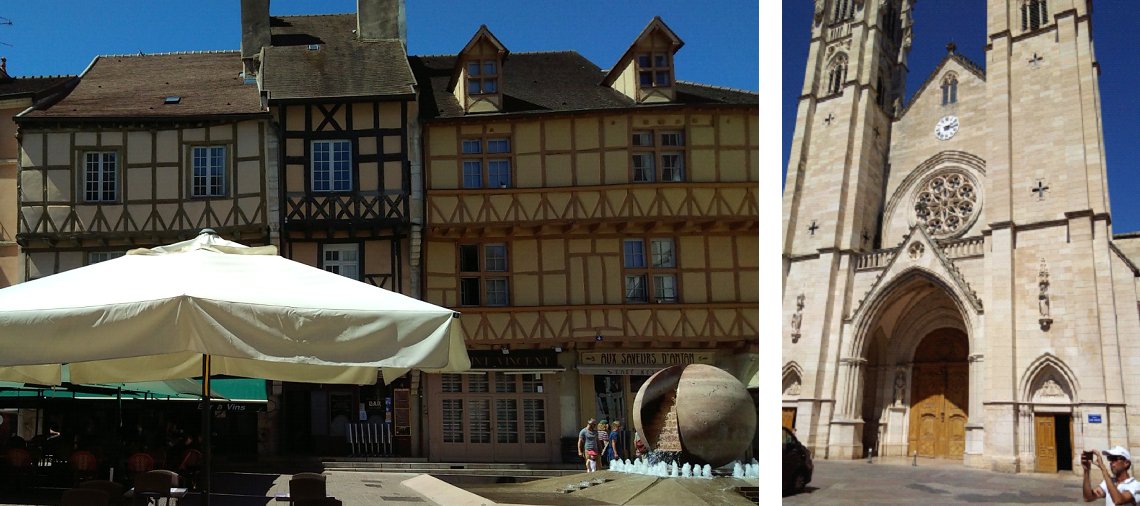
The market place and the cathedral of Chalon-sur-Saône.
In Tournus, our destination for tomorrow, there is only a public wharf directly on the river Saône, with no booking possibility, but we see very few vessels around and we are not worried.
August 6, Thursday: Chalon-sur-Saône - Tournus [31 km, 1 lock, 4h]
After the usual check to oil and water, we leave at 10. We spend half an hour waiting for the opening of the Ormes lock, and at 14 we find our spot along the public pontoon of Tournus.
We make a tour around the town and then we stop for a white beer in the bistrot just in front of the warf, under a green arbour. Despite masks and social distancing, things look relaxed here, and indeed we are not going to toil too much!
We book for a mooring in Mâcon, where they tell us that there is all the room we may need.
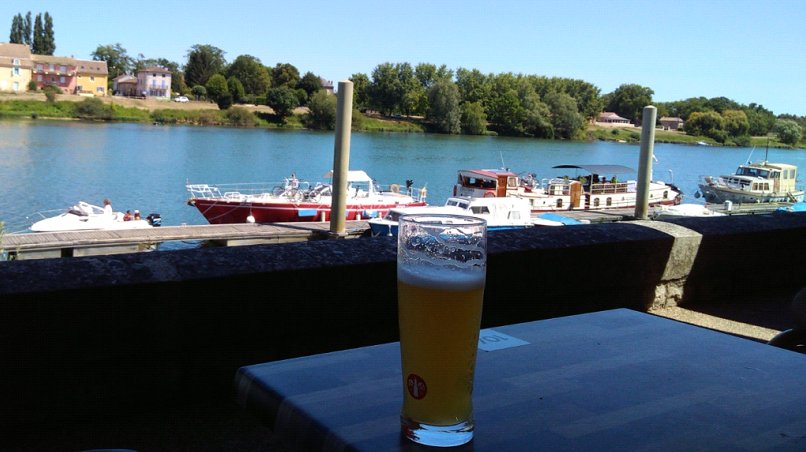 |
The halte nautique of Tournus, seen from the bistrot under the trees just in front. |
August 7, Friday: Tournus - Mâcon [30 km, no locks, 3h]
Departure at 10. No locks today! We arrive at 13 in the port de plaisance of Mâcon (Pk 83), out of the town towards the north. Instead of mooring at the visitors' pontoon, we take by mistake the place of a resident boat, but the office is closed for lunch; one hour later the staff tells us to stay where we are, as the owner is not coming back before the end of next week.
We ride with our bikes across a wonderful park and a series of bike lanes down to the city, and then walk around the narrow roads and a number of roman churches, with a stop for a refreshing beer. Temperatures are always above 35 °C.
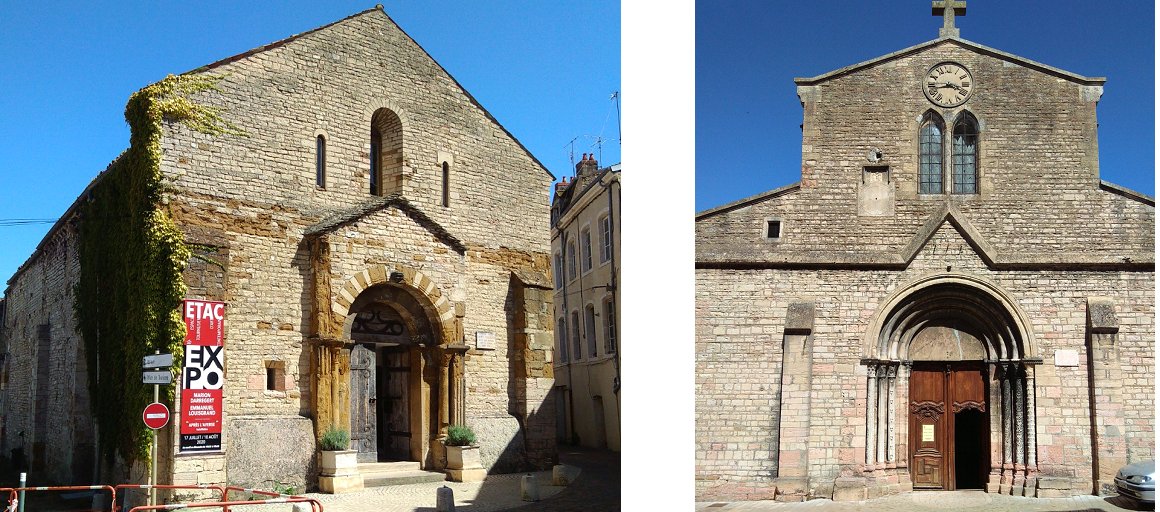
The roman churches of Mâcon.
Back on board we call the port de Confluence of Lyon, the only place where we may stop, as it's forbidden to moor alongside the berges downtown: we book a mooring for Sunday and Monday. Unfortunately Margherita already let us know that for working reasons she won't come: we will end our journey in three.
August 8, Saturday: Mâcon - Villefranche-sur-Saône [42 km, 1 lock, 4h30]
We leave at 9:45. We pass through the Dracé lock (Pk 62) almost without waiting and at 14:10 we tie up to the short pontoon of the halte nautique of Jassans-Riottier, on the left bank of the Saône, opposite the small town of Villefranche-sur-Saône.
There is nothing around, and Villefranche is too far away for a ride. The only building is a nice open-air restaurant 100 metres away from the pontoon, and we have dinner there in the evening.
August 9, Sunday: Villefranche-sur-Saône - Lyon [42 km, 1 lock, 5h]
Departure at 9:45 after the usual check of oil, water and weeds. The lock at Rochetaillée (Pk 17) is already open: we are running much quicker than expected, and all downstream locks are an easy job: we hope it's going to last also along the Rhone.
At 14:45 we get into the port de Confluence of Lyon, a small basin digged downtown into the left bank of the Saône, one kilometre from the intersection between Saône and Rhone. Even if booking was due, in the harbour we find one other vessel only. The marina manager assigns us one of the many free fingers and advices to have always somebody on board, even if the marina acces is secured by a gate with an entry code, because Lyon is not really the safest place in France: this will be André's task, as he's going to stay anyway due to his little walking autonomy.
Temperaturs have raised over 37 °C and it's too hot to walk around the town: we will make a tour tomorrow morning with a more pleasant temperature.
August 10, Monday: Lyon
We stay in Lyon for a day dedicated to tourism: we walk around the old city, and climb with the cable railway to the cathedral of Notre-Dame de Fourvière and the roman theatre, still in use, without forgetting a good brasserie.
Back on board at the beginning of the afternoon when temperatures begin to rise, we fill up our water tanks and make some fresh provisions at the hypermarket just in front of the marina.
Now we must make an accurate planning, as there are a few places to stop along the Rhone; we are restarting from Pk zero. We have to take into account the south-going stream that may create some troubles while manoeuvring, enough to oblige us to make a U-turn upstream when we approach a mooring, except inside the locks or at the waiting pontoons, that are always sheltered from the stream.
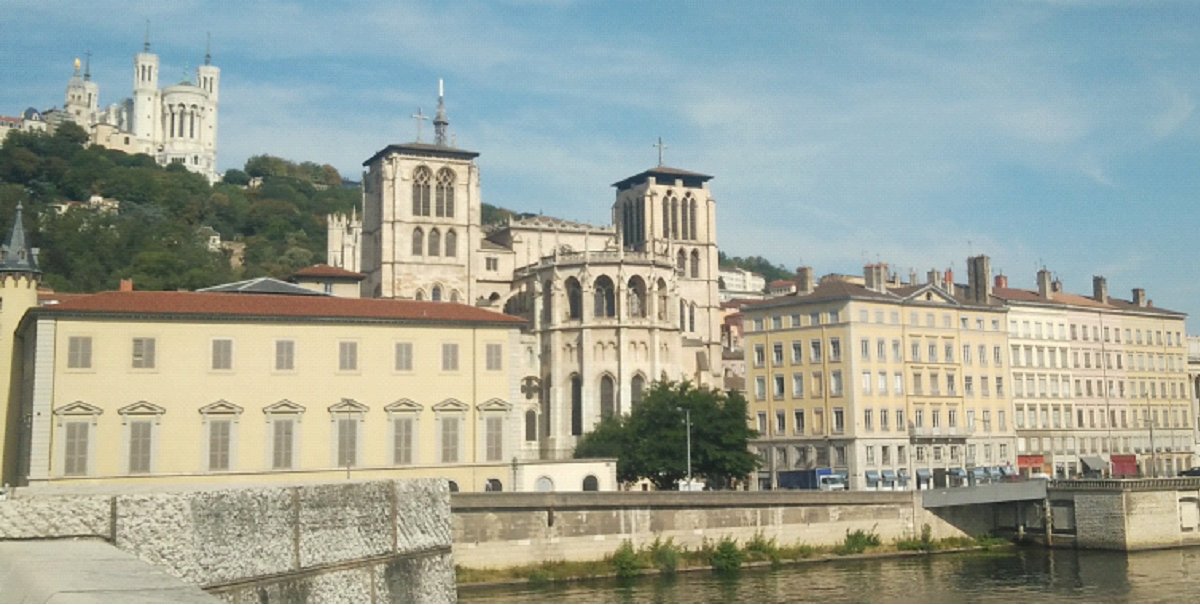
The right bank of Lyon along the Saône, with the cathedrals of Notre-Dame di Fourvière, up the hill,
and of Saint Jean, almost on the bank.
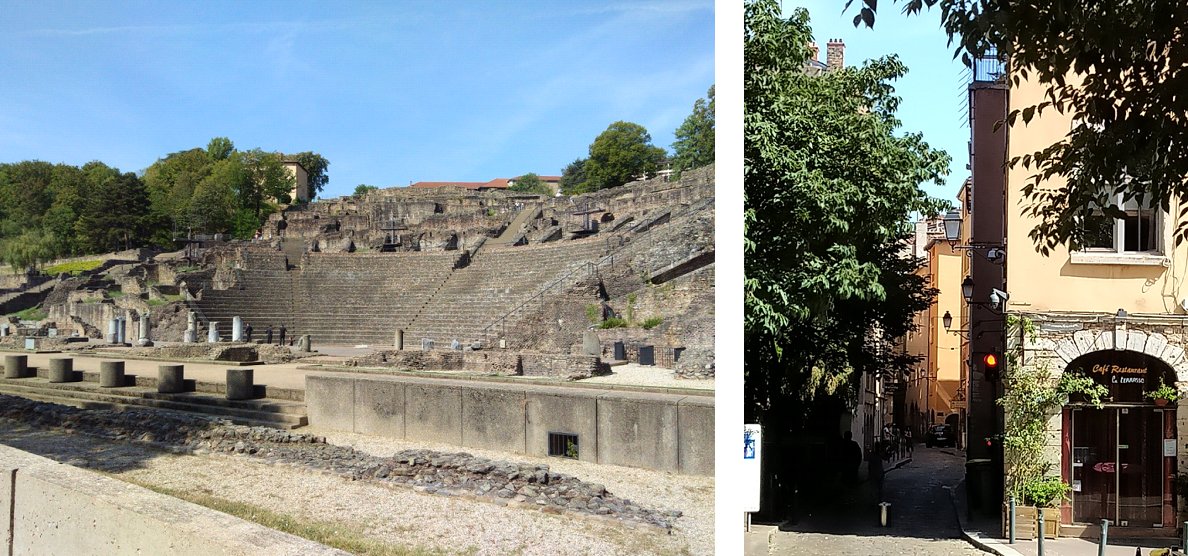
The roman theatre of Fourvière and the small roads of the old Lyon.
August 11, Tuesday: Lyon - Les-Roches-de-Condrieu [41 km, 2 locks, 4h30]
After a phone call to the port de plaisance of Les-Roches-de-Condrieu and a second call to the Pierre-Bénite lock (Pk 4, the first lock in the Rhone, 1 hour ahead of the marina), we leave Lyon at 10. At 11 we are in front of the lock, already open for us, and we make the first ‘jump’ of 12 metres.
Almost all locks of the river Rhone are placed inside a small lateral canal, while in the main arm of the river there is a dam with a power station. Lock basins are all equipped with floating bollards that go up and down together with the boat, avoiding the displacement of ropes as in Holland or Belgium. At Pierre-Bénite we have some difficulty in taking both a bow and a stern bollard, because their distance is at barge length. In exchange there is no water turbolence at all during the bassinage. We also learn that along the Rhone it is compulsory to wear our life jackets inside the locks (we never did it before) and that the lock-keeper doesn't begin the operation until he sees that everybody is wearing one.
The double floating bollards in the large locks on the Rhone. | 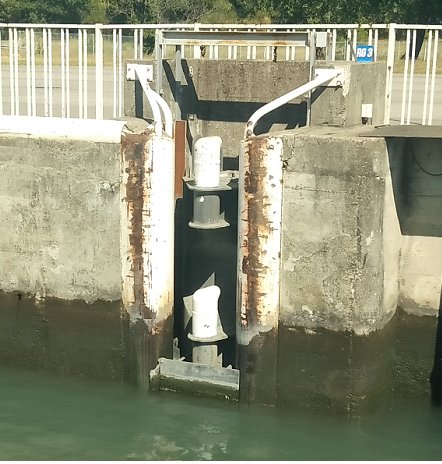 |
At 13:30 we get to the Vaugris lock, waiting for 15 minutes, and while mooring we hit the wall with our bow anchor, because of the distance between the bollards and the swing of the vessel when reversing: we have to invent something better. On the other hand commercial traffic is not worrying at all, and in any case all locks have a small waiting pontoon for pleasure crafts just before.
At 14:30 we tie up at the second pontoon of the port de plaisance of Les-Roches-de-Condrieu (Pk 41). Despite our turists' ambitions, the small town has nothing to offer, but there is some light wind that makes the oppressive heat acceptable. The harbour basin has been gained from a Rhone bend during the works to straighten the road for commercial barges; the resulting short dead arm is now equipped with water games, in particular a nice round towing circuit for water-skiing with jumps. This is also the only place with some shadow, and we enjoy the spectacle in front of a refreshing beer.
August 12, Wednesday: Les-Roches-de-Condrieu - Saint-Vallier [35 km, 1 lock, 4h]
We leave at 9:45, with some southerly wind, therefore always against us, as the Rhone is almost straight. The Rhone is majestic, large, with the sorrounding countryside where vineyards alternate with cultivated fields. Today we have to stop at a halte nautique where booking is not possible, but we see no vessels around and therefore we are not worried.
At the Sablons lock (Pk 59) we wait 45 minutes for a commercial barge behind us. We try to tie to one single bollard at about midship with one rope only, managing any possible swing with the gaffs once steady, and when possible mooring on the left side of the basin to avoid the rotation due to the propeller: it seems this works very fine.
At 13:40 we arrive at the halte nautique of Saint-Vallier (Pk 76), completely empty.
In the evening, a small péniche with some young people that need to load their provisions (and a birthday cake!) comes alongside with a manoeuvre not really among the best... We help them in tying up and loading their stuff, and before dinner they leave southwards; we make a phone call to the port de plaisance of Valence and book a place.
August 13, Thursday: Saint-Valier - Valence [36 km, 2 locks, 4h]
Departure at 9:30. At 10:30 we go through the Gervans lock, 15 metres of fall and 15 minutes of waiting pontoon, and at 13 through the lock of Bourg-les-Valence, already open for us. Our technique with a single bollard-single rope at midship on the left wall of the basin is winning: one crew could be enough. Moreover, the traffic is really small and the lock-keepers have no problems in letting us go through even if there's nobody else: in short, the ride down the Rhone is showing up much easier than expected.
At 13:30 we get into the port de plaisance of l’Épervière, in Valence. We make a ride downtown, at some distance north of the harbour, following the bike path along the Rhone: the town is very nice.
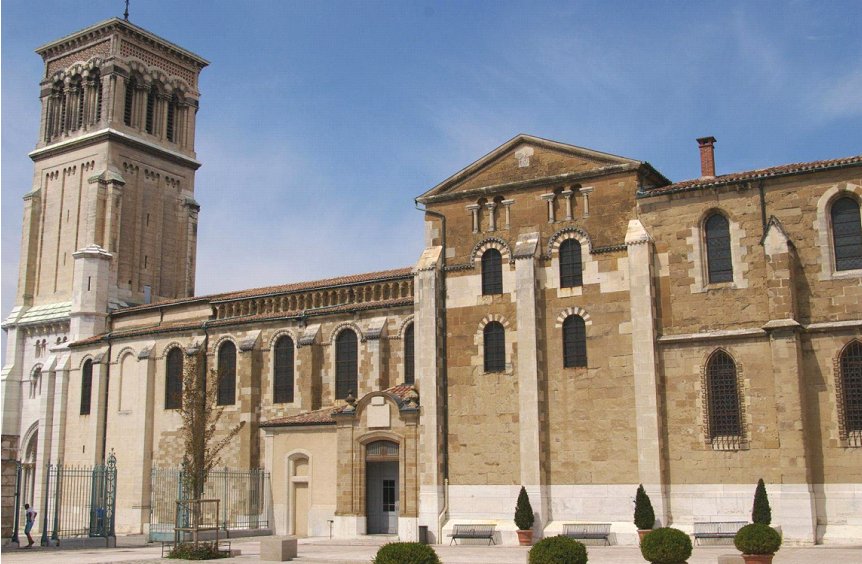 |
The roman cathedral of Saint-Apollinaire in Valence. |
August 14, Friday: Valence - l’Ardoise (Port 2) [111 km, 5 locks, 11h]
We leave at 8:30, with the aim of getting to Viviers, with as many as 3 locks on the way! The highest number this year, nothing in comparison of last year, when we reached 20 locks in a single day.
We pass the Beauchastel lock without waiting (Pk 124), the lock of Logis-Neuf in 15 minutes and Chateauneuf already open.
At 14:30 we look for a spot at Viviers with no success: the harbour is too small and already full; we go ahead. At 16:30 we pass through the Bollène lock (Pk 187), the highest on the Rhone and in all French waterways, with a fall of 23 metres and sliding gates like in a giant guillotine: really impressive.
Around 17:30 we pass beside the village of Saint-Étienne-des-Sorts, where our guide gives a halte nautique, but there's is nothing there: the pontoon should have been taken away by a flood during the winter and never restored. We go ahead again, also because we cannot do anything else, but at this point we make a call to a marina called ‘Port 2’ at the end of the short lateral arm of l’Ardoise, as this is the only other place we are able to reach today: hopefully they have room, and even if we'll be there quite late, they are going to wait for us.
At 18:30 we pass through the Caderousse lock (Pk 215), already open, and at last, after a sharp turn into the arm of l’Ardoise and after another 5 kilometres, we tie up to the pontoon of Port 2: it's 19:15 but the marina manager is waiting as promised.
What we've done today is the longest route we can sail on the Rhone in one day, and for the first time we are a bit tired. Beyond the small harbour the place is wild, circled by trees, and the only sound we hear is the water flowing through the dam aside of the Caderousse lock.
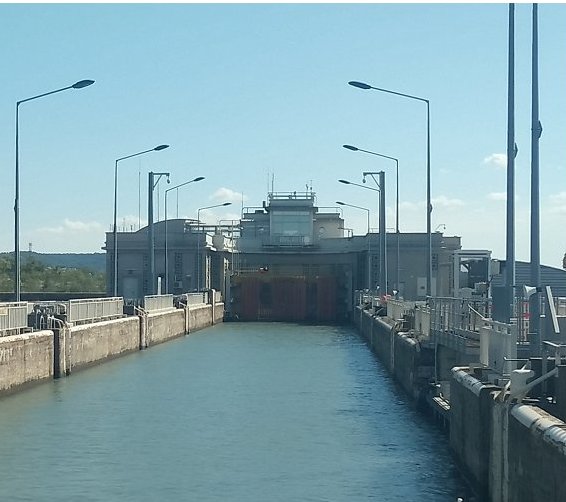 |
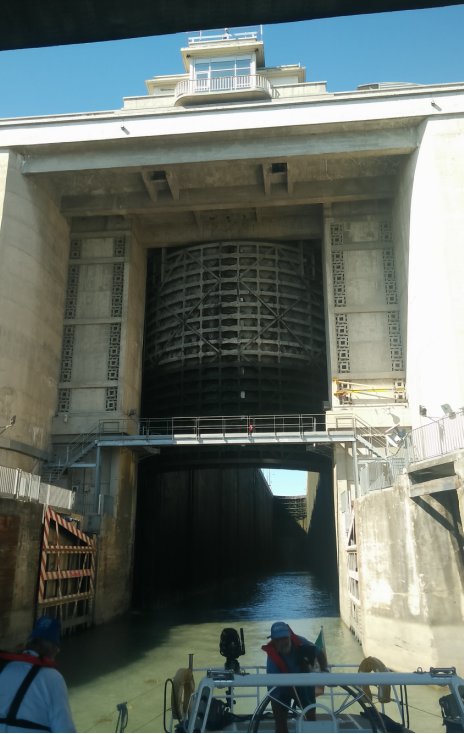 |
The Bollène lock, when going in and after getting out. | |
 | |
August 15, Saturday: l’Ardoise - Avignon [20 km, 1 lock, 3h30]
When we wake up in the morning, we find on the deck a bag with three warm croissants: what a service! We leave at 9:30 towards Avignon. The halte nautique in Avignon is considered one of the most visited, but despite it's placed in a big town, there is no booking possible: we hope to find a place, being there at the end of the morning.
At 11:30 we pass through the Avignon lock (Pk 235), already open, and a short time later we make a U-turn into the Avignon arm of the Rhone. Passed by the stump of the famous bridge, at 13 we tie up to the quai de la Ligne in Avignon, in the next to last place.
Due to Covid, the big barge hosting the marina office and services is closed, but in exchange the stop is free of charge. As there are still 34 °C, a cold shower on board is fine.
During the afternoon the quai de la Ligne gets deserted and we decide to act as in Lyon, waiting for better temperatures tomorrow morning to make a tour downtown. We take a small public ferry across the river, where a huge park hosts many camping sites and a few open-air bars, under the trees, where we stop for a refreshing beer and a better view on the Avignon bridge, the town walls and the Popes palace.
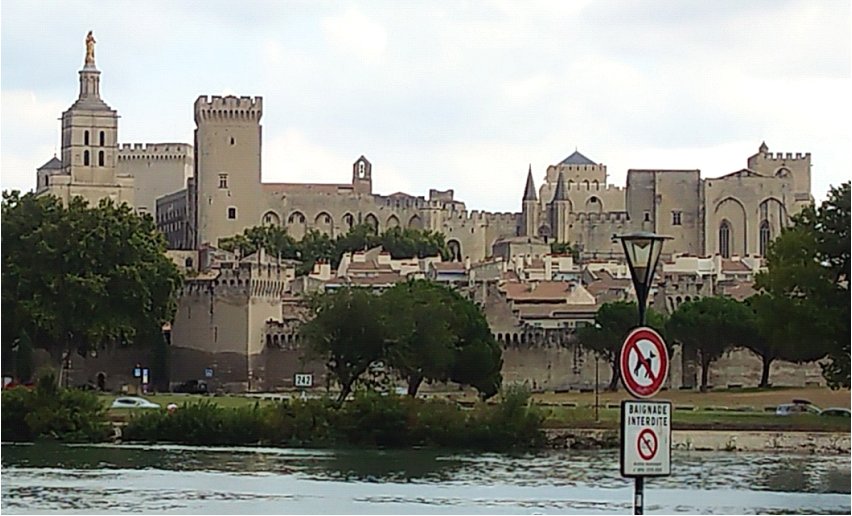 |
Avignon seen from the opposite bank of the side arm of the Rhone. |
August 16, Sunday: Avignon
We stay in Avignon: Ecland is moored right under the walls of the old town and it's a nice view despite the road traffic nearby.
After a ride around the town walls, we ask if it's possible, without booking, to visit the Popes palace. There are not many tourists and we get a ticket for a visit one hour later, so we spend the time waiting in a bistrot just in front of the palace with a good beer.
The visit is wondeful and there is really nobody inside, we find just a couple of people in each of the rooms full of history, that we enjoy reading the guide picked up at the entrance. We go on wandering around the old town for a few hours: I've never walked so much this year! During the night, a powerful thunderstorm cools down the air.
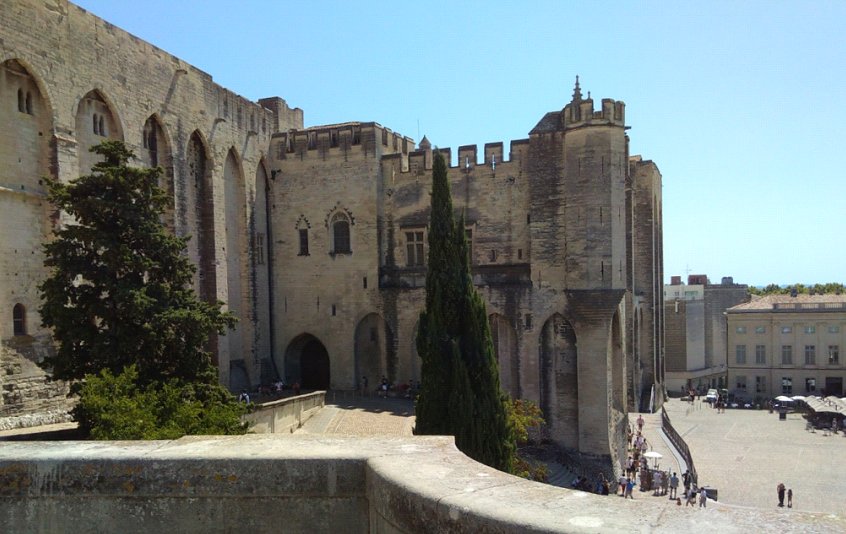 |
The Popes palace, papal seat during the Avignonese Captivity, from 1308 to 1377. |
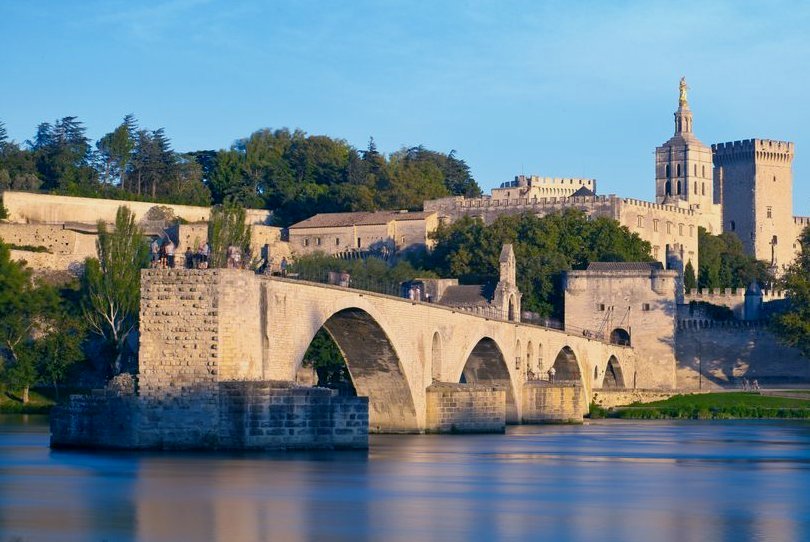 |
«Sur le pont d’Avignon... on y danse tous en rond.» |
August 17, Monday: Avignon - Arles [44 km, 1 lock, 5h]
Departure at 10. As a last stop before getting to the end we would like to stop in Arles, where our guide indicates a halte nautique with a 50 metres long pontoon. At 12 we are in front of the lock of Beaucaire (Pk 265), the last large lock down the Rhone, and we wait one hour to get through. Then we pass along Tarascon and its beautiful Angevin fortress.
The Angevin castle of Tarascon. | 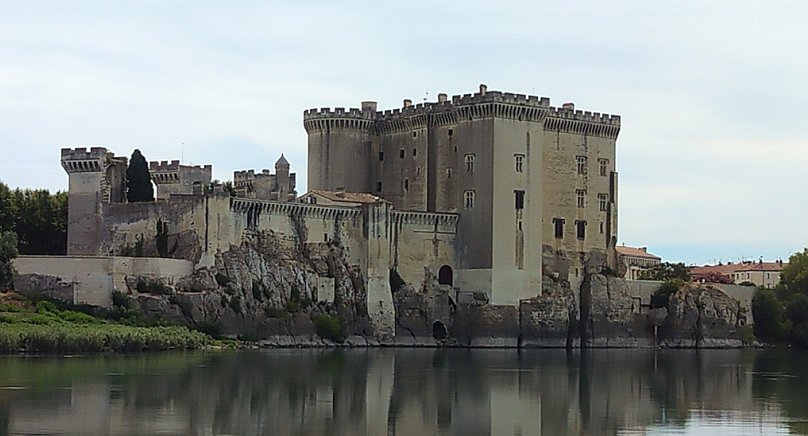 |
At 15 we arrive in Arles, but there's not a shadow of the halte nautique. There is just a microscopic pontoon filled with a number of pedalos, and in any case so small than I wouldn't dare to approach. We see on the wall of the right bank the huge sign ‘Halte nautique d’Arles’, but the pontoon must have been taken away by a flood in past years.
We switch to plan B, as shown on the guide, calling on the phone the floating restaurant “La Péniche”, told to accept visiting vessels alongside, if one books for a table at dinner, which is a reasonable compromise. Alas, today is their weekly rest and they don't want to know about us. On the other side, it's too late to get to the end of the river, and we really wish to visit the roman archaeological monuments in Arles. After a couple of ups and downs along the walls, where the concrete is shaped with a set of teeth at water level and therefore unapproachable, we see a small length with some wooden horizontal planks, sign that somebody else used to stop there.
We approach very carefully, and eventually we moor on the right bank of Arles in a real non-orthodox way, tying our ropes to the steel of the steps used to climb on top of the the bank and to another piece of iron coming out from the concrete, over slightly more than 1,5 m of water. There is no wind at all and we are something out of the stream, so we decide to stay. We are moored almost below the local VNF quarter.
We leave André staying on board with a mobile ready to call us for any emergency, and we go for a turn around the roman monuments of Arles, a World Heritage site: the cryptoportici, the roman theatre, the thermae, the coliseum.
Once back on board, at about 18 we are called by two VNF officers from the bank who inform us that it's forbidden to stay along the town walls, because of the water level fluctuations operated by the dam of Beaucaire. We look each other a bit upset, but after we explain our reasons, the VNF guys answer that tonight we are “tolerated”, warning us to survey the soundings; after a wave, they go. Uff!
A little later a bigger sailing vessel comes from the south, slowing down under the bridge looking for a possible mooring, and of course they come towards us, approaching the wall very slowly. Eventually they give it up, and ask if they may come alongside, but this is out of the question, due to our insecure position and the fact that their boat is much heavier. After another round, they go on northwards; they may be able to get to Avignon before dark, if they succeed in passing the Beaucaire lock before closing time. Bon voyage!
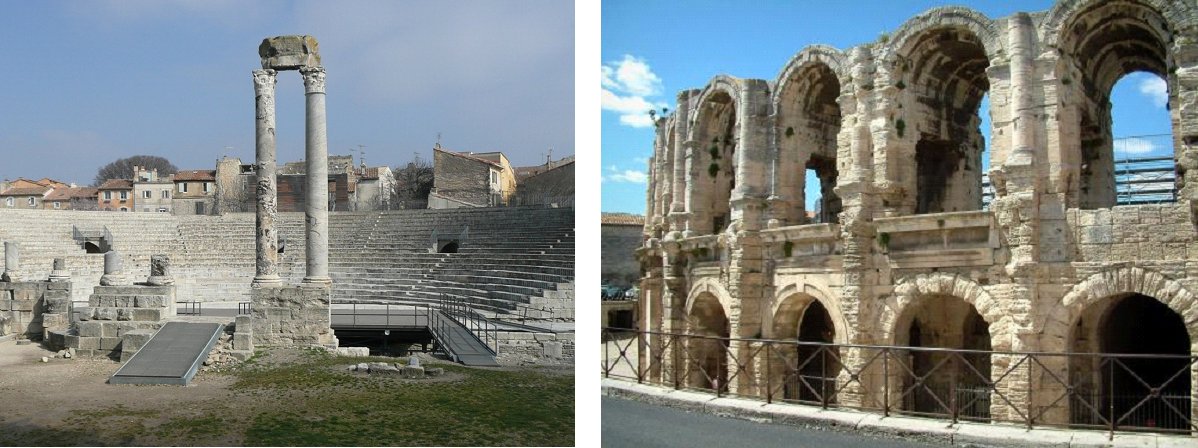
The roman theatre and the external walls of the coliseum in Arles.
August 18, Tuesday: Arles - Mediterranean Sea (Port Napoléon) [52 km, 1 lock with bridge, 7h of wich 1:30h turning around]
We are ready to leave at 10:30. Actually the water level has risen by 10 cm tonight, but as it has not fallen, we have no problems.
Around us the landscape is now flat, and vegetation is made by Mediterranean bush. On our right we begin to catch sight of the Camargue swamps.
At 14 we are in front of Saint-Louis-du-Rhône, where the last lock, smaller than the others and with a modern lifting bridge, makes the passage between the Rhone and the harbour, directly linked with the Mediterranean Sea. Unfortunatley there is no pontoon to wait for the lock, that opens at fixed times: the next opening is at 15:30; after a check on the phone with the lock-keeper, we turn around up and down the last kilometre of the Rhone, until we are called because there's a commercial barge passing through (barges are not limited by the pleasure crafts schedule) and will be room for us inside the basin.
 |
The modern lifting bridge at the northern tip of the lock of Saint-Louis-du-Rhône, which links the Rhone with the open sea. |
We get into the locks at 15, but the scheduled time is now too close, and the lock-keeper decides to wait for all other pleasure crafts to come. The falling here is negligible, maybe 50 centimetres.
At 16 Ecland gets out of the lock and under the lifting bridge and meets Mediterranean waters again, after exactly 28 years.
Past the Saint-Louis inner basin, we run eastwards for 5 kilometres to round the end of the long breakwater and get into the gulf of Fos, and then another 5 kilometres westward along the dradged channel leading into Port Napoléon. At 17:20 we tie up to one of the visitors' pontoons of the marina. Summing up, the section from Dijon to the see has been easier and more relaxing than expected.
August 19-23: Port Napoléon
We have arrived to the end of our journey, and the cruise is off, but not our duties: we still have to prepare our mast for remasting, then put the mast on and afterwards move Ecland to her final mooring.
During 19 and 20 we have our mast ready to be fitted in place. It's hot but there is some sea breeze and the weather is fine. We also complete papers and finantial issues with the marina staff – with a special arrangment given to Cruising Association members – always with masks and at safe distance.
We work hard on the mast fitting, reassembling with no troubles rigging, furler, crow's nest and instruments, and we are able to put forward to Friday afternoon the masting operation, mainly after the request of the crane operator, who lets us clearly understand that on Saturday our masting would have been his only manoeuvre, and he would prefer very much to stay at home!
|
On Friday 21 the crane operator comes at 9 while we are having breakfast, asking if we are ready, and so we move to the dock beneath a wonderful jib crane of 50 tons; thanks to this machine – and to the operator's skills – we remast very smoothly. At 13 we have finished and move Ecland to her final spot, further inside the marina. We take advantage of the afternoon to book our trains from Marseille and to make a quick jump downtown Saint-Louis and buy a few provisions for the last days.
We spend the rest of 21 and 22 fixing and trimming the rigging, cleaning inside and outside and making all needed works for Ecland's wintering. On Friday evening we have a nice dinner at the small marina restaurant, even to celebrate my birthday with some delay. Hopefully we anticipated the remasting operations: mistral began to blow hard Friday nigh, and on Saturday it's already too strong for the crane to manoeuvre. |
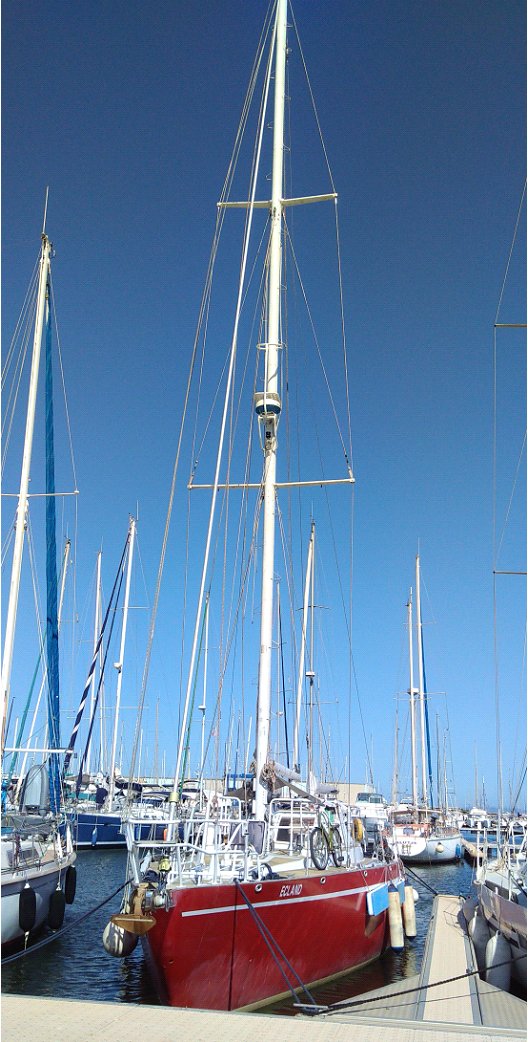 | |
What a pleasure to see Ecland with her mast standing again, ready to sail. |
On Sunday 23 we take a taxi to the Gare de St-Charles in Marseille, leaving Ecland ready to sail again with little works to do.
Ten days after we are back home, people arriving at Milano Centrale from France are already put in quarantine for the second Covid wave...
Conclusion
Summing up the figures of this European crossing form north to south,
from Amsterdam to the gulf of Fos, we have eaten up in almost 7 weeks
and a half 1900 kilometres, sligthly more than 1000 nautical miles – not
very much indeed, if you think that in a ‘normal’ sailing month we use
to make more than 1500 miles, with some night crossing – passing through
270 locks, 4 tunnels, 1 lift and 16 lifting bridges, with a total of
275 hours under power, including accidents and hitches.
Despite the troubles with our engine of the first year and the deviation caused by drought, both cruises have been fantastic: new friends, places not to be missed, a cruising rhythm and an atmosphere completely different from what we were used to when sailing at sea.
In hindsight, should we have attempted the west-to-east route, we were probably somewhere along the Danube waiting for the wet season.
I would never expect that an inland waterways cruise could be so adventurous. To be honest, I don't think I would make it again: Ecland has to voyage under sail, and so do we; but I have no regrets: once in one's life, it's worth the experience.
The protagonists of the adventure
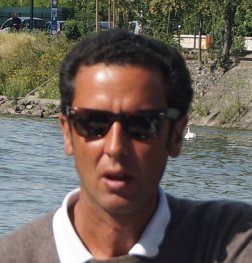 |
 |
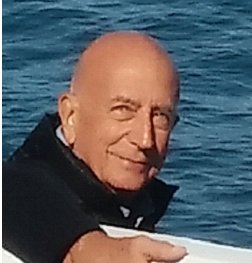 |
 | |
 |
 |
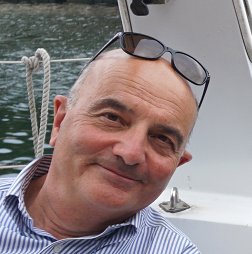 |
 | |
 |
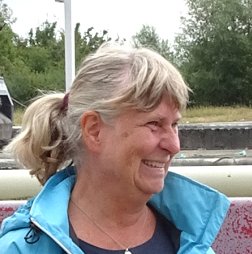 |
 | ||
Michele Magni | ||||
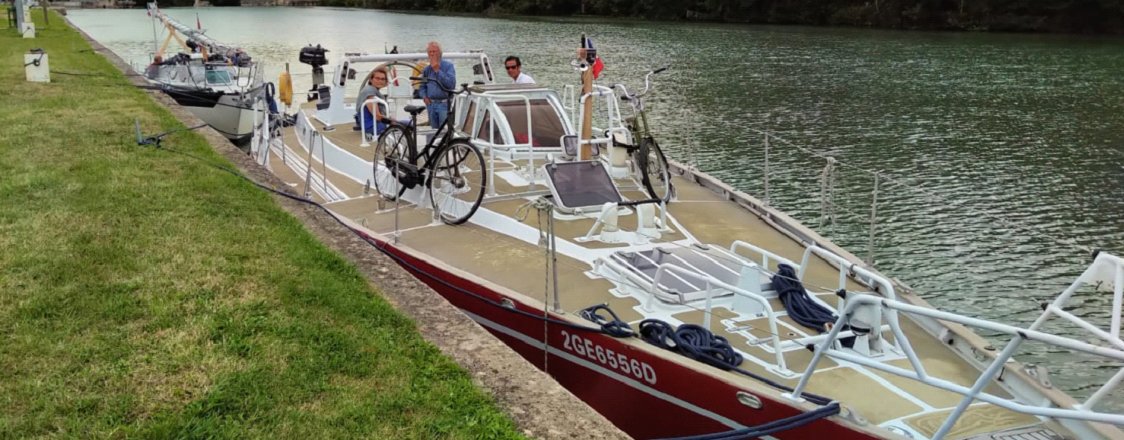
And of course Ecland and La Cane, here moored just after the Isles lock, on the river Marne.
November 2020
You can download the Pdf file of this logbook from here.
You can also view the whole route by downloading this file .kml:
– in Google Earth, select File-Import and load the .kml file into the temporary places;
– in Google My Maps, open a new map and a new layer and drag the .kml file into the window.
 PDF DOWNLOAD
PDF DOWNLOAD VERSIONE ITALIANA
VERSIONE ITALIANA TOP
TOP